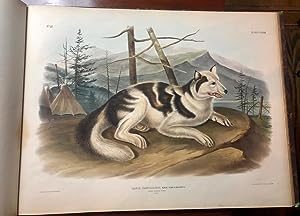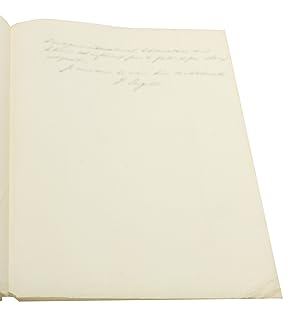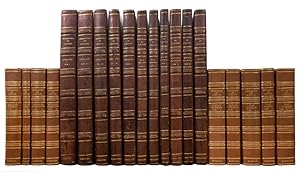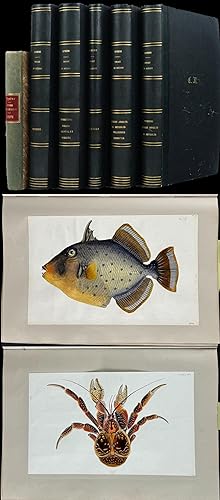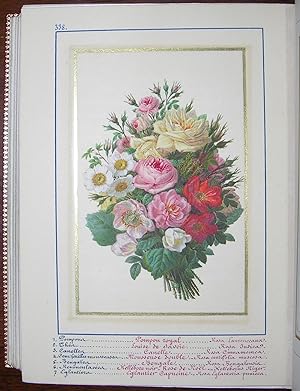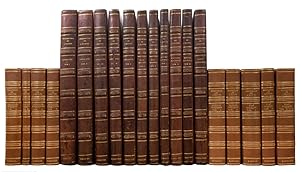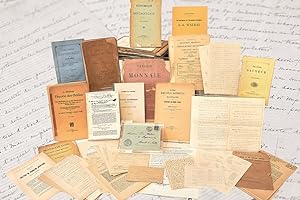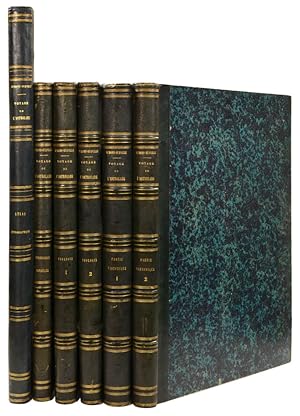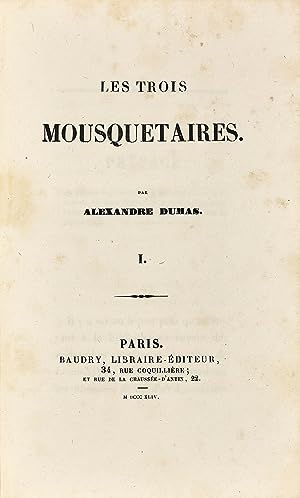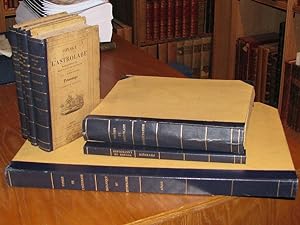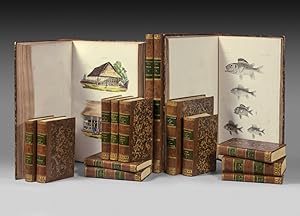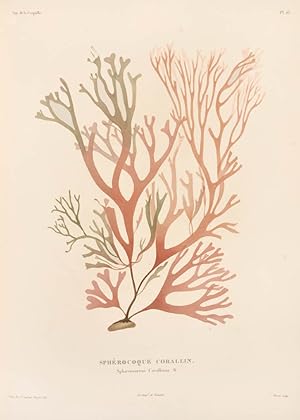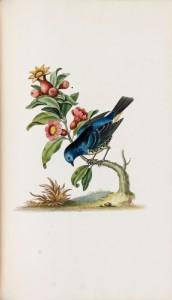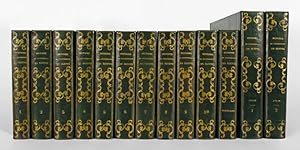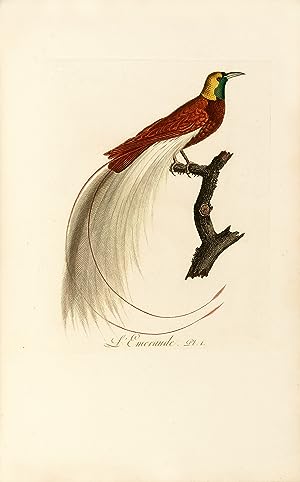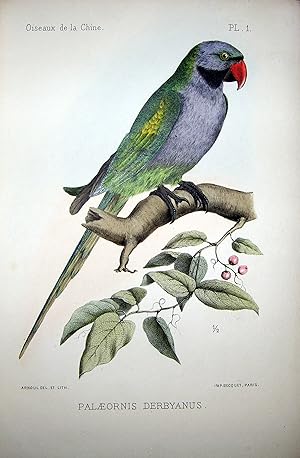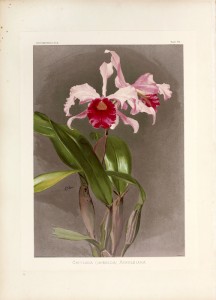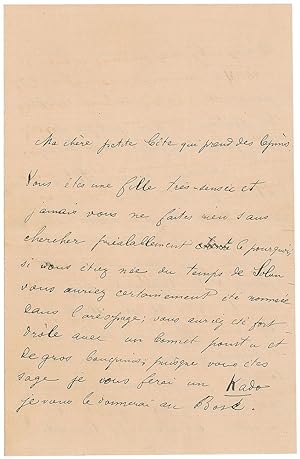histoire (Plus de 135 000 résultats)
Type d'article
- Tous les types d'articles
- Livres (130 638)
- Magazines & Périodiques (1 395)
- Bandes dessinées (7)
- Partitions de musique (31)
- Art, Affiches et Gravures (1 043)
- Photographies (662)
- Cartes (1 376)
-
Manuscrits &
Papiers anciens (322)
Etat
Reliure
Particularités
- Edition originale (19 557)
- Signé (3 875)
- Jaquette (551)
- Avec images (88 820)
- Sans impression à la demande (135 428)
Livraison gratuite
Pays
Evaluation du vendeur
-
The Viviparous Quadrupeds of North America.
Edité par New York: J.J. Audubon (--V.G. Audubon), 1845-1848., 1848
Vendeur : Arader Galleries - AraderNYC, New York, NY, Etats-Unis
Livre Edition originale
Hardcover. Etat : Very Good. 1st Edition. "4 volumes of elephant broadsheets bound as oblong folios (28 x 21 3/4 in.; 55.3 x 71.1 cm). 3 lithographed title-pages and 3 letterpress contents leaves, 150 lithographed plates by J. T. Bowen after John James and James Woodhouse Audubon, backgrounds after Victor Gifford Audubon, handcolored and heightened with gum arabic; titles and contents toned, moderate marginal dust-soiling on most plates, some finger soiling, plates 1, 62, 72, 73, 81 creased chiefly in upper lefthand corner, tape repairs to tiny tears along bottom margins of plates 112-113, small oil stains in gutters of about 13 plates, chiefly in the fourth volume. Contemporary quarter red morocco over brown marbled boards, spines gilt in six compartments lettered "Histoire Naturelle" in the second, numbered in the fourth, and monogrammed in the sixth; extremities rubbed; minor loss to head of spine (vol. 1), vol. 2 head of spine torn but present. FIRST EDITION OF THE ONE OF THE GREATEST COLORPLATE BOOKS PRODUCED ENTIRELY IN AMERICA IN THE NINETEENTH CENTURY. After an unsuccessful attempt to secure federal funding for his "Great Western Journey," Audubon determined that the commercial potential of the Quadrupeds was sufficient to risk funding the expedition himself. "To render [the Quadrupeds] more complete, I will leave the comforts of my home and beloved family, bound to the Rocky Mountains I cannot tell how long I may be absent, but look to return loaded up knowledge, new and abundant specimens on the shot and not from stuffed museums' moth-eaten remains. I am told that I am too old to undertake such a long and arduous journey, but having the will, I will no doubt safely bear or even surmount the difficulties" (letter to C. Bonaparte, February, 1843, quoted by Rhodes). To his collaborator the Rev. James Bachman, he exclaimed "I am growing old, but what of this? My spirits are as enthusiastical as ever, my legs full able to carry my body for ten years to come, and in about two of these I expect the illustrations out, and ere the following twelve months have elapsed, their histories studied, their descriptions carefully prepared and the book printed!" (Streshinsky, Audubon: Life and Art in the American Wilderness, p. 332). It was to be J.J. Audubon's last major endeavor. Returning home in late fall of 1843 aged 58 and in declining health, he delegated many of the smaller mammals to his son John Woodhouse to draw and the backgrounds to his youngest, Victor Gifford, who also supervised the printing and publication. Despite Audubon's optimistic timeline for the completed work, it took the family five years to publish 150 plates in thirty parts. The first proofs were ready in 1842, but Audubon was Audubon's lithographer J.T. Bowen was immersed in the production of the octavo set of The Birds of America. The last part of the octavo Birds appeared in May, 1844, and publication of the folio Quadrupeds began immediately, with the first number being issued in January, 1845 and the first volume completed within the year. The accompanying octavo text volumes, written and edited by Rev. John Bachman, first appeared between 1846 and 1854. "The massive project was a commercial success, thanks to the close management of Victor" (Reese), attracting a total number of 300 subscribers. REFERENCES: Bennett p. 5; McGill/Wood 208; Nissen ZBI 162; Reese 36; Sabin 2367 PROVENANCE: Gilt cypher in sixth spine compartment; J.R. Walsh (stamps on title-pages and contents leaves); Acquired from Nico Isreal, 1978; The Richard Harris Collection: Natural History and Colourplate Books (Bloomsbury, 13 October 2010, lot 3: $504,000).
-
Autograph letter signed ("F. Engels").
Edité par London, 31. III. 1873., 1873
Vendeur : Antiquariat INLIBRIS Gilhofer Nfg. GmbH, Vienna, A, Autriche
Manuscrit / Papier ancien
8vo. 1¼ pp. on bifolium. To the publisher Maurice Lachâtre, detailing his conditions for an envisaged biography of Karl Marx and a history of the Communist Party: "Dans votre lettre du 16 mars, vous paraissez croire que 'je vous présente un livre sur le parti communiste' tandis que c est vous qui, en me demandant d écrire une biographie sérieuse de Marx, m aviez demandé l histoire de ce parti. Marx ayant mené une vie essentiellement active, raconter sa vie, c est faire l histoire du mouvement philosophique & révolutionnaire allemand & international depuis 1842 pour y tracer sa participation personnelle & l influence de ses écrits. Si vous ne désirez qu une biographie de reporter, c est déjà fait. L Illustration en a publié une, & si vous m en envoyez un exemplaire, je suis prêt d y faire les corrections nécessaires. L étude que je comptais faire devant être un travail sérieux, j aurais cru vous faire injure en supposant que vous qui dans cette affaire commerciale prenez le rôle de capitaliste, vous auriez voulu échapper à cette première règle sociale, appliquée même dans notre société bourgeoise, que le capitaliste paie le travailleur proportionnellement à son travail. Cependant, comme vous dites que vous n agrandissez votre capital que pour le mettre au service de la communauté, je consens à donner mon travail, à la condition que vous consacrerez une somme à la fondation d un organe international hebdomadaire dont le besoin est impérieux pour le parti, & que Marx rédigerait [.]". ("In your letter of March 16 you appear to believe that 'I present you a book on the Communist Party' although it is you who, in asking me to write a serious biography of Marx, has asked me for a history of the party. As he led an essentially active life, to recount Marx's life is to write the history of the German and international philosophical and revolutionary movement since 1842, so as to trace his personal participation and the influence of his writings. If you just expect a reporter's biography, that has already been done. 'L'Illustration' published one and if you send me a copy of it I am willing to do the necessary corrections. The study that I hoped to undertake must be a serious work. I would have believed to have wronged you in supposing that you, who in this commercial matter takes the role of the capitalist, would have wished to escape from that first social rule which is applied even in our bourgeois society that the capitalist pays the worker in proportion to his labor. However, since you say that you only increase your capital in order to allocate it to the community, I consent to give my labour under the condition that you will grant a sum to the foundation of an international weekly organ that is urgently needed by the party and that Marx would edit [.]"). - In a letter to Lachâtre from 16 March 1872, Engels had quite enthusiastically agreed to the project in principle but urged the publisher to set out his conditions. The response apparently left Engels dissatisfied. Although he was still willing to collaborate with Lachâtre, the project never came about. The present letter reveals the interesting detail that Engels planned to publish a weekly organ for the First International with Karl Marx as editor. Between 1872 and 1875 Maurice Lâchatre published the first French translation of "Das Kapital" and was therefore in close contact with Marx. - Slightly creased with traces of dog-ears to the lower corners. - Not in: Marx/Engels, Werke vol. 33 (Briefe Juli 1870 - Dezember 1874).
-
Description De l'Egypt
Edité par Imprimerie Impériale [then] Royale, Paris, 1809
Vendeur : Temple Rare Books, Oxford, Royaume-Uni
Edition originale
Hardback. Etat : Good+. First Edition. 21 vols bound in 20 (9 volumes quarto text, 1 volume elephant folio text [bound with Antiquities vol I], 11 elephant folio plate volumes), the complete set of 894 plates of which 40 are wholly or partly printed in colours and or hand-coloured, and 2 printed in bistre, many double-page, and or, folding, plate DD in Etat Moderne II with fore-margin sometime renewed, scattered light foxing, contemporary calf gilt with marbled paper panels to covers (moiré cloth panels to natural history vols.), text volumes rebacked to style, spine gilt lettered and ruled, 1809-1830. ANTIQUITIES - 5 vols: (I) Engraved frontispiece, map, 99 plates numbered 1-97 (plates 79 and 87 each in two states) + 1 unnumbered plate; Bound with folio text; (II). 92 plates numbered 1-92; (III). 69 plates numbered 1-69 ; (IV). 72 plates numbered 1-72 + 2 plates lettered e & f ; (V). 89 plates numbered 1-89. ETAT MODERNE - 2 vols. (I). Engraved map, 83 plates numbered 1-83; (II). 22plates numbered 84-105 + 31 plates numbered I-XXXI + 11 plates lettered A-K + 9 plates lettered AA-II + 4 plates lettered KK-NN + 9 plates lettered a-i + 1 plate lettered k (JJ and j not used). HISTOIRE NATURELLE - 2 vols bound in 3: (I). 62 plates; (II). 105 plates; (II bis). 77 plates. Amongst the artists who contributed to this section are Barraband, Bessa, Redoute, and Turpin. CARTES GEORAPHIQUE ET TOPOGRAPHIQUE - engraved title & 52 engraved plates. Provenance: Bookplate of Algernon Percy, 4th Duke of Northumberland (1792-1865). Volumes with either the Garter Crest or Ducal bookplate. Percy, the second son of Hugh, the second Duke, was a distinguished naval officer and a man of science and learning, who rose to the rank of Admiral, and was First Lord of the Admiralty in 1852. Percy became Duke of Northumberland in 1847, and a Knight of the Garter in 1852. FIRST EDITION OF ONE OF THE MOST AMBITIOUS SCIENTIFIC, HISTORICAL, ARTISTIC AND PUBLISHING PROJECTS - A COMPLETE SET WITH FINE ENGLISH PROVENANCE. THE FIRST COMPREHENSIVE DESCRIPTION OF ANCIENTAND MODERN EGYPT, THE OUTSTANDING ACHIEVEMENT OF THE SAVANTS WHO ACCOMPANIED NAPOLEON'S EXPEDITION TO EGYPT (1798-1801). THE WORK IS THE GREATEST OF A NUMBER OF OUTSTANDING SCIENTIFIC PUBLICATIONS BY THE FRENCH GOVERNMENT DETAILING THE RESULTSOF EXPLORATION, UNEQUALLEDBY ANY OTHER NATION DURING THE SAME PERIOD. The only flaw in Napoleon s preparations for the invasion of Egypt was a miscalculation when it came to Turkey s reaction to France s unsolicited help in dealing with its mostly unruly vassals, the Mamluks of Egypt. Had it not been for this, Napoleon s plan for following up military conquest by revolutionising the economy and institutions of Egypt might well have created a modern European-style state, controlled by France, at the axis of all the trade routes between Europe, India and the East. Plans to this end involved nearly 500 civilians, the cream of whom were about 150 men drawn from the Institut de France. Once in Egypt their first task was to make a thorough survey of every aspect of the country to assist the planning of its future shape, and this was extended to include Antiquities. The work was co-ordinated by L Institut de l Egypte (later replaced by the Commission des Sciences et Arts d'Egypte), founded in the appropriated house of Hassan Kachef (illustrated in the plates to the Etat Moderne), with Gaspar Monge as president.As early as October 1798 Fourier was entrusted with the task of uniting the reports of the various disciplines with a view to publication. Following the capitulation of the army to Egypt under General Menou (a convert to Islam), the savants returned to France where a commission was set up for the editing and supervision of the work. The first volumes were published by Napoleon s government, and it is a measure of how important this work was considered to be that publication continued following the Bourbon restoration. . never before or since has a study of such scope and thoroughness been accomplished.
-
Flore des Antilles, ou Histoire générale botanique, rurale, et économique des végétaux indigènes des Antilles.
Edité par Paris: Chez l'Auteur, F. Schoell et Hautel, 1808-1827 [1828], 1828
Vendeur : Arader Galleries - AraderNYC, New York, NY, Etats-Unis
Edition originale
4 volumes in 2, folio (20 1/4 x 13 in.; 51.4 x 33 cm). 140 stipple-engraved plates printed in color and finished by hand by Bouquet, Dien, Gabriel, Massard, Robert and others after Redouté, Poiteau, Turpin, and others (a few heightened with gum arabic in vol. 3), title-pages for vol. 1 in French and Latin, dedication to Louis XVIII in vol. 2; short closed tear in upper gutter pl 8 of vol. 1, pl. 24 of vol. 3 shaved at outer margin, some occasional faint spotting to plates and light foxing (chiefly marginal) to text and vol. 1 title-page, text leaves to plates 11-27 and terminal leaf browned in vol. 4, and plates in vol. 4 misbound (as 1-4; 6; 9; 5; 7-8; 10-37). Contemporary green morocco richly gilt by J. Wright, covers ruled with triple fillets and embellished with roll-tool borders incorporating grape, floral, pineapple, and acorn tools, the spines in 6 compartments gilt with floral tools and raised bands (one reserved for lettering), gilt dentelles, marbled endpapers, edges gilt. THE BOTFIELD COPY OF THIS EARLY FLORA OF THE WEST INDIES, FIRST EDITION. According to Brunet, only 150 copies of this lavish work were published in 32 fascicules. Relatively little is known of Tussac's early life, but as a botanist he travelled around the West Indies, visiting Santo Domingo and Martinique in 1786, Haiti and Jamaica in 1802. In Haiti he briefly became curator of a botanic garden before returning to France at the end of that year. Tussac's preface to this work gives a vivid account of his travels and adventures, as well as an account of Toussaint-Louverture's slave rebellion in Santo Domingo. Most of his drawings had been destroyed by fire during the rebellion, but he was able later to recreate them from his notes and collected specimens. REFERENCES: Brunet V:987; Nissen BBI 2017; Great Flower Books 78; Dunthorne 312; Stafleu & Cowan TL2 15:397 PROVENANCE: Beriah Botfield (his sale, Christie's London, 30 March 1994, lot 90; Christie's New York, 6 December 2013, lot 188; Sotheby's New York 18 December 2019, lot 203).
-
First Zoological Inventory of Polynesia - Noury's Fregate la Sireneâ ¦ 458 Original Illustrations in 5 Volumes, 1 Hand-written Text Volume, and 1 Modern publication of the Manuscript
Date d'édition : 1850
Vendeur : Trillium Antique Prints & Rare Books, Franklin, TN, Etats-Unis
Art / Affiche / Gravure Signé
Hardcover. Etat : Fine. This historically significant manuscript is the 'First Zoological Inventory of Polynesia.' The work based on the research of Charles-Gaëtan Noury is entitled Frà gate la Sirene, commendà e par Mr. Noury Capitaine de Frà gate. Histoire naturelle. Voyage dans l'Oceanie, annà es 1847, 1848 & 1849. Iles de la Socià tà , Tahiti & Marquises, Nouka hiva and was unknown until 2017. The work was completed in France after 1850.The manuscript is in 6 volumes, one volume of text and five volumes with 458 illustrations (including 444 watercolors, 10 pen drawings, and 4 pencil drawings). Each illustration is mounted on card and often has French handwritten descriptors with local names. The five volumes with illustrations are bound in green half morocco with gold details and monogram of C.N. to the front boards. The text volume is bound in half-cloth. Also included in the lot is the manuscript published on behalf of the Belgian Academy of Sciences by Michel Jangou after the discovery of this one of a kind work of Noury's. Jangou's publication is entitled Voyage en Polynà sie (1847-1850): Le bestiaire oublià du capitaine Noury and was published in Brüssel in 2017 (available on Amazon as well).All of the illustrations and text were based on the scientific findings of Charles-Gaëtan Noury. It encompassed the entire animal kingdom of Polynesia creating the 'First Zoological Inventory of Polynesia.' Michel Jangou commented in his publication of the manuscript that "Noury produced a pioneering work, the first zoological inventory of Polynesia! He compiled it discreetly, with the invaluable help of a talented painter who remains anonymous. Since then, Noury 's manuscript and the watercolors which illustrate it have remained ignored by everything: it took more than a century and a half for the captain's work, still intact, to find the light and finally be revealed to us." (p. 39)Noury divided the animals into individual classes. The artist depicted the animals with brilliant colors and a mastery of detail. The manuscript depicted several previously unknown species. Watercolor number 183 features a detailed autographed commentary from Noury himself. Noury's text was mainly dedicated to his zoological findings with a smaller section on plants. The individual classes and sections are introduced by a summary table, which follows Milne Edwards zoological classification system of mammals, birds, reptiles, fish, ringed animals, insects, myriapods, arachnids, crustaceans, molluscs, and zoophytes. His descriptions were often enriched with island anecdotes.Charles-Gaëtan Noury (1809-1869) was a French naval officer and naturalist. He boarded the Sirà ne in Brest, France in 1846 as the deputy to Commander Lavaud. Lavaud had been appointed governor of the French settlements in Oceania. While Lavaud served as governor, Noury had command of the Sirà ne and stationed in Papeete (Tahiti). He dedicated himself to scientific research there and with the help of painters produced this remarkable astonishing manuscript.Noury had one work published in Nantes in 1861 entitled Album Polynà sien de M. C. Noury, Capitaine de Vaisseau which showed images of tattoos and artifacts of South Sea curiosities. This work with 15 plates is currently on the market at 25,000 EUR.This one of a kind manuscript from Noury offered here remained undiscovered for over 160 years. It features 458 illustrations and hand-written scientific text that make it a truly astonishing work for any collection.Additional photos available upon request. --- The work is in very good to excellent condition overall. The bindings are slightly rubbed. There can be some faint foxing to title or illustrations. There may be a few minor imperfections to be expected with age. Please review the image carefully for condition and contact us with any questions. --- Paper Size Image or Sheet Size ~ 12 3/4" by 8 1/4"; Mounting Card Size ~ 16 3/8" by 11 3/8" Image or Sheet Size ~ 12 3/4" by 8 1/4"; Mo. Signed by Author.
-
Les Roses.
Edité par [Paris]: Léon Curmer, 1861-1863., 1863
Vendeur : Arader Galleries - AraderNYC, New York, NY, Etats-Unis
3 volumes. 16mo., (5 ¾ x 4 ¾ inches). ORIGINAL MANUSCRIPT half-titles and vignette title pages LAVISHLY ILLUMINATED IN GILT AND COLOR. 113 EXQUISITE MINIATURE WATERCOLORS plus frontispieces; 3 engraved plates, original pen sketch and 2 photographic portraits inserted (very occasional offsetting, engraved plates slightly toned). Contemporary red morocco, green morocco gilt doublures, green moiré silk guards, by Marius Michel; red levant chemises and pull-off cases by Hardy-Mennil (chemises worn but holding). Provenance: With the armorial device of Léon Curmer (1801-1870) in the center and his monogram at head and foot of the doublures, his sale, Paris, 22 May 1874. With the bookplate to verso of front free endpaper of Robert Hoe, his sale, Part IV, Anderson Auction Company, 18 November 1912 (describing a fourth volume). General Brayton Ives, his sale, American Art Association, 6 April 1915. Donated to the Hispanic Society of American in 1955 by Archer M. Huntington (describing only three volumes, as here). Christie's sale 2059, Fine Printed Books and Manuscripts Including Americana, 5 December 2008. A SUPERB COLLECTION OF MINIATURE PAINTINGS OF ROSES BY A STUDENT OF REDOUTÉ. Manuscript on paper. Includes "Histoire de la Rose" by Edouard Cadol and Delongchamps (1859), with quotations from French poets, written within blue and gold borders. Rembert was a student of Redouté who produced two such manuscripts for Curmer, the present one and "Les Fleurs" (February 1858-1861-3 April 1862). The prefatory page of "Les Fleurs" says of Rembert: "qui pourrait se glorifier d'etre élève de Redouté, s'il n'était lui-même un maître" ("who could boast of being Redouté's student, even if he himself was not a master"). "Les Roses" took two years to make and was described in the Curmer sale catalogue as an "admirable manuscript." The publisher and bookseller Léon Curmer (1801-1870), who specialized in botanical art, was one of the first publishers to make systematic use of chromolithography to reproduce Medieval illuminated manuscripts in color. He also applied this new and innovative technique to photography. He opened his bookshop in 1833, going bankrupt in 1845 but continuing to publish many works over the next 20 years. He is perhaps best known for his edition of "Paul et Virginie" (1836-1838), one of the most illustrated books of the Romantic period. Marius Michel (born Henry-François-Victor Michel, 1846-1925) was a French gilder and art binder trained by his father Jean Michel, becoming his partner in 1866 before founding a bindery together in 1876. "A CHARMING COLLECTION, the text of which is formed by the 'History of the Rose' by Edouard Cadol and Delongchamps, and by poems referring to the Rose. All the paintings were executed by Ferdinand Rembert from specimens furnished by the most celebrated cultivators of roses, and the butterflies and insects were painted after the suggestion of M. Deyrolle. The names of the roses were given by Eugène Verdier and Edouard André" (quoted in the Anderson catalogue: A Catalogue of Manuscripts Forming a Portion of the Library of Robert Hoe, New York: Privately Printed, 1909, p.197). Catalogued by Megan Scauri.
-
Description de l'Egypte, ou recueil des observations et des recherches qui ont été faites en Égypte pendant l'expédition de l'armée française, publié par les orders de Sa Majesté l'Empereur Napoléon
Edité par Paris Imprimerie Impériale then Royale -1822 -1830, 1809
Vendeur : Shapero Rare Books, London, Royaume-Uni
Livre Edition originale
First edition. 21 vols bound in 20 (9 volumes quarto text, 1 volume elephant folio text [bound with Antiquities vol. I], 11 elephant folio plate volumes), the complete set of 894 plates of which 40 are wholly or partly printed in colours and or hand-coloured, and 2 printed in bistre, many double-page, and or folding, plate DD in Etat moderne II with fore-margin sometime renewed, scattered light foxing, contemporary calf gilt with marbled paper panels to covers (moiré cloth panels to natural history vols.), text volumes rebacked to style, spine gilt lettered and ruled. Antiquities, 5 vols: (I) Engraved frontispiece, map, 99 plates numbered 1-97 (plates 79 and 87 each in two states) + 1 unnumbered plate; Bound with folio text; (II). 92 plates numbered 1-92; (III). 69 plates numbered 1-69 ; (IV). 72 plates numbered 1-72 + 2 plates lettered e & f ; (V). 89 plates numbered 1-89. Etat Moderne, 2 vols. (I). Engraved map, 83 plates numbered 1-83; (II). 22 plates numbered 84-105 + 31 plates numbered I-XXXI + 11 plates lettered A-K + 9 plates lettered AA-II + 4 plates lettered KK-NN + 9 plates lettered a-i + 1 plate lettered k (JJ and j not used). Histoire Naturelle, 2 vols bound in 3: (I). 62 plates; (II). 105 plates; (II bis). 77 plates. Amongst the artists who contributed to this section are Barraband, Bessa, Redoute, and Turpin. Cartes Georaphique et topographique, engraved title & 52 engraved plates. First edition of one of the most ambitious scientific, historical, artistic and publishing projects - a complete set with fine English provenance. The first comprehensive description of ancient and modern Egypt, the outstanding achievement of the savants who accompanied Napoleon's expedition to Egypt (1798-1801). The work is the greatest of a number of outstanding scientific publications by the French government detailing the results of exploration, unequalled by any other nation during the same period. The only flaw in Napoleon's preparations for the invasion of Egypt was a miscalculation when it came to Turkey's reaction to France's unsolicited 'help' in dealing with its mostly unruly vassals, the Mamluks of Egypt. Had it not been for this, Napoleon's plan for following up military conquest by revolutionising the economy and institutions of Egypt might well have created a modern European-style state, controlled by France, at the axis of all the trade routes between Europe, India and the East. Plans to this end involved nearly 500 civilians, the cream of whom were about 150 men drawn from the Institut de France. Once in Egypt their first task was to make a thorough survey of every aspect of the country to assist the planning of its future shape, and this was extended to include Antiquities. The work was co-ordinated by L'Institut de l'Egypte (later replaced by the Commission des Sciences et Arts d'Egypte), founded in the appropriated house of Hassan Kachef (illustrated in the plates to the Etat Moderne), with Gaspar Monge as president. As early as October 1798 Fourier was entrusted with the task of uniting the reports of the various disciplines with a view to publication. Following the capitulation of the army to Egypt under General Menou (a convert to Islam), the savants returned to France where a commission was set up for the editing and supervision of the work. The first volumes were published by Napoleon's government, and it is a measure of how important this work was considered to be that publication continued following the Bourbon restoration. '. never before or since has a study of such scope and thoroughness been accomplished on the basis of field work carried out in so short a space of time and under such inadequate and harrowing circumstances' (J.C. Herold, Bonaparte in Egypt, 1963). Antiquities describes not only the ruins, but also the objects excavated, including the Rosetta Stone, here described for the first time. The quality of the plates was much enhanced by the use of an engraving machine invented by Conte, which is itself illustrated among the plates. Etat Moderne describes the architecture of Egypt subsequent to the Arab invasion in the seventh century, particularly Cairo, as well as sections on Art et Métiers, Costumes et Portraits, Vases, Meubles et Instruments, and Inscriptions, Monnaies et Médailles. Algernon Percy, 4th Duke of Northumberland was the second son of Hugh, the second Duke, a distinguished naval officer and a man of science and learning, he rose to the rank of Admiral, and was First Lord of the Admiralty in 1852. He became Duke of Northumberland in 1847, and a Knight of the Garter in 1852. Atabey, 343; Blackmer, 476; Brunet II, 616-617; Nebenzahl, Maps of the Holy Land, 60; Nissen, BBI, 2234; Nissen, ZBI, 4608; Wilbour pp178-185.
-
Histoire de L´Église de France - 12 Volumes
Edité par Chez L´Auteur \ Chez Jules Renouard Etc Cie., 1857
Vendeur : Livraria Nova Floresta, Sao Paulo, SP, Brésil
Livre Edition originale
Hardcover. Etat : Good. 1st Edition. A presente obra encontra-se em bom estado de conservação, contém manchas amareladas causadas pelo tempo e anotação a caneta na folha de rosto do volume 2. Na encadernação, há desgastes na capa e lombada. Formato: 15 x 22 Conservação da capa: Bom Estado Conservação do miolo: Bom Mess weight 8750g.
-
Voyage pittoresque autour du monde, avec des portraits de sauvages d'Amérique, d'Asie, d'Afrique, et des iles du Grand Ocean; des paysages, des vues maritimes, et plusieurs objets d'histoire naturelle.
Edité par Paris: Firmin Didot, 1820, 1822., 1820
Vendeur : Arader Galleries - AraderNYC, New York, NY, Etats-Unis
Edition originale
Half-Leather. Etat : Fine. Remainder of title: "Accompagné de descriptions par M. le Baron Cuvier, et M. A. de Chamisso, et d'observations sur les cranes humaines par M. le docteur Gall." Folio (16 x 10 inches): 2 letterpress title-pages dated 1820 and 1822, Dedication, list of subscribers and plates at end. Lithographic frontispiece portrait of Romanzoff and 104 hand-colored plates from drawings by the author, or after the author by Adam, Franquelin, Norblin Morlet and de Chamisso, folding map with route traced in color, 2 further maps on one leaf bound at end of volume (some spotting and browning). Contemporary French half red morocco, smooth spine gilt, marbled boards. "ONE OF THE VERY VALUABLE AND FUNDAMENTAL WORKS ON ALASKA, CALIFORNIA, AND THE HAWAIIAN ISLANDS" (Lada-Mocarski). VERY RARE FULLY COLORED COPY OF THE FIRST EDITION of Choris' splendid plates to illustrate Kotzebue's world voyage of 1815-1818 on which he was expedition artist. Essentially, this is an illustrated album recording only the most memorable facts of the voyage but with full explanations of the plates--more of which relate to California, Hawaii, Kamchatka and Alaska than any other work of the period--and the Philippines, Chile and Easter Island. It is arranged in 8 sections which were first sold in 22 livraisons, 1820-1822 (although both Brunet and Howes state that publication ended in 1823). Two title-pages were printed, dated 1820 to accompany the first livraison, and 1822 for the successive parts. There was only one issue of the text and plates, according to Forbes, and although a lithographic portrait of the artist is found in a few copies, its presence does not constitute an issue point. Indeed, it may have been produced only after the work was completed. The text was written and edited by J.B. Eyries and the list of subscribers accounts for 188 copies. Two variant plates are noted by bibliographers, both present here: plate II for the Sandwich Islands shows Kamehameha in a black robe, and plate XVI has been re-worked to include a lush background with the artist seated in the foreground watching dancers. Choris' manuscript text of the voyage was never published but his album is highly prized for its beauty and its historical record. Forbes writes that it contains "a final and very beautiful pictorial examination of the Hawaiian Islands and of Hawaiian culture as it existed prior to the death of Kamehameha I in 1819, and prior to the abolition of the 'kapu' or feudal system following the king's death." REFERENCES: Brunet I:1851 (calling for 110 plates); Forbes 541; Hill 290; Howes C-397; Lada-Mocarski 84; Peters California on Stone pp. 97-98; Sabin 12884; Streeter sale IV:2461. Book.
-
Histoire naturelle des oiseaux de paradis et des rolliers, suivie de celle des toucans et des Barbus
Edité par Paris: Denné le jeune and Perlet, [1801] -1806, 1806
Vendeur : Arader Galleries - AraderNYC, New York, NY, Etats-Unis
Edition originale
2 volumes, folio (20 1/4 x 13 1/4 in.; 551.4 x 33.7 cm). 114 fine stipple engraved plates after Jacques Barraband by Bouquet, Grémilliet, and Perée, printed in color and finished by hand; half titles and indices in both volumes, errata leaf for both volumes at the end of vol. 2, this issue without the phrase "Libraire de S.A.I. le Prince Joseph" after Denné's name in the imprint; some marginal foxing to a few plates, scattered foxing or spotting affecting about a dozen plates, occasional foxing (chiefly marginal) to text. Fine contemporary diced Russia, paneled gilt, central gilt emblem of the arms of the Knight of Order of the Garter embellished with the armorial stag of the Earls of Dartmouth on an azured field, the spines in 7 compartments gilt, marbled endpapers, edges gilt; rebacked, preserving the original spines, hinges strengthened. FIRST EDITION OF LEVAILLANT'S SPECTACULAR WORK ON EXOTIC BIRDS. Until Gould, Levaillant was the unparalleled producer of the most comprehensive series of works on exotic birds (Fine Bird Books). The present work was originally issued in 19 parts between 1801 and 1806. The superb plates after Barraband effortlessly capture the striking, unique characteristics and rich coloring of each exotic bird species, featuring 24 birds of paradise; 15 rollers; 17 jays; 18 toucans, 24 barbets, 5 tamatias, 3 barbacous; and 8 jacamars. A pupil of Joseph Malaine, Barraband first worked as a draughtsman at the Gobelins tapestry factory and then as an artist for the Sèvres porcelain manufactory. But his work later in life for Levaillant undoubtedly marked the high point of his career and made abundantly clear why he was considered the best ornithological artist of his generation. FROM THE DISTINGUISHED LIBRARY OF THE EARLS OF DARTMOUTH, probably acquired by the 3rd Earl at the time his investiture as a Knight of the Order of the Garter in 1805. Dartmouth served as lord steward of the household from August 1802 and as lord chamberlain from May 1804. He was a trustee of the British Museum from 1802 to 1810. REFERENCES: Anker 304; Ayer/Zimmer p. 393; Fine Bird Books (1990), p. 118; C. Jackson, Dictionary of Bird Artists of the World (Woodbridge, 1999), p. 148; McGill/Wood p. 434; Nissen, IVB 559; Ronsil 1780 PROVENANCE: George Legge, 3rd Earl of Dartmouth (1755-1810, gilt supralibros); William Heneage Legge, 6th Earl of Dartmouth (1851-1936, early 20th century bookplate on front pastedown); A. J. Dearden (inscribed on bookplate and dated 1925 and on verso of front free endpaper of vol. 1).
-
Flore des Antilles, ou histoire generale botanique, rurale et economique des vegetaux indigenes des Antilles
Edité par Paris: chez l'auteur, F. Schoell et Hautel, 1808-1818-1824-1827., 1827
Vendeur : Arader Galleries - AraderNYC, New York, NY, Etats-Unis
Edition originale
4 volumes in 2, large folio (20 6/8 x 14 inches). Half-titles, title-pages for each volume in both French and Latin (spotted throughout, pages 29-80 in volume IV very browned). 137 of a possible 140 stipple-engraved plates printed in colours and finished by hand, by Bouquet, Dien, Gabriel, Massard and others after Dabnour, Poiteau, Pretre, P.J. Redoute and Turpin, including plates bis 25 in volume one, plates 2,4, 10 and 19 magnificent double-page plates, bis 1 in volume III (bound without plates 20, 31 and 32 from volume II as noted by Quaritch in 1976, some mostly marginal spotting throughout). Contemporary green paper boards, each spine with two red morocco lettering-pieces, all edges uncut (joints starting, extremities a bit worn). Provenance: with the green ink library stamp of the Society of St. Sulpicius at the end of both volumes, and on the title-page of volume III; Arpad Plesch, his sale Sotheby's 16th March 1976; Robert de Belder (1921-1995) and his wife Jelena de Belder-Koracic (1925-2003), horticulturists and proprietors of Arboretum Kalmthout, their sale Sotheby's 28th April 1987, lot 366 First edition, LARGE PAPER COPY, of which Brunet says: 'Il n'a ete tire que 150 exemplaires' (only 150 copies printed). The number of plates found in each copy varies: Dunthorne, Davy de Virille and Brunet mention 138 plates, Stafleu 137 of 140 plates. Regardless of the number, these magnificent coloured illustrations of the exotic flora of the West Indies are amongst the earliest published, and are surely the most sumptuous. When Europeans first arrived in the West Indies the islands were mostly covered by forest. Centuries of cultivation have altered that landscape considerably, but the islands remain rich in exotic native flora. The earliest botanical surveys of the islands were carried out by French and British naturalists, nearly two hundred years after the discovery of the Americas. These include the work of Plumier (1693, 1703, 1755-60) in the French colonies, and the work of Plukenet (1691), and Sloane (1696, 1707-1725) in the British colonies. Their publications are richly and superbly illustrated and depicted plants never before seen by the Europeans. Tussac was a French botanist born in Poitou, who moved to Martinique in 1786. "After some years collecting plants on Martinique, Tussac became curator of a botanic garden in Haiti. In 1802 he left Haiti and visited Jamaica before returning to France, where he later took up the directorship of the botanic garden at Angers (1816-1826). He published Flore des Antilles between 1808 and 1827 [as here]. Tussac made 2,000 drawings while in Martinique which were burnt in 1802 during the Haitian war of independence (his herbarium and manuscripts were saved, though the whereabouts of the latter is unknown). The tree fern Cyathea tussaccii (syn. Alsophila tussacii (Desv.) D.S. Conant) collected by Tussac was named after him by his son-in-law, Auguste Desvaux, also his successor at Angers" (Natural History Museum online). The plates are after the leading botanical artists of the time, such as Poiteau, Turpin, Pretre, Redoute and Risso. Dunthorne 312; Nissen 2017; Stafleu TL2 15.397. Catalogued by Kate Hunter.
-
Histoire Naturelle des Perroquets.
Edité par Paris chez Levrault fréres Libraires quai Malaquai -1805, 1801
Vendeur : Shapero Rare Books, London, Royaume-Uni
Livre Edition originale
First edition, first state; 2 vols; folio (53 x 35 cm); half-titles, 145 etched plates after illustrations by Jacques Barraband printed in colour and finished by hand, table of contents to end of each vol., occasional light spotting, mostly to margins; contemporary burgundy straight-grained morocco gilt, upper and lower panels with wide gilt borders of palmettes, enclosing Meander roll in blind and inner gilt panel, gilt spine in 7 compartments, all edges gilt, minor restoration to corners and spine caps, each vol. housed in red cloth clamshell case with contrasting black calf lettering-pieces to spine. First edition in the preferred folio format of this celebrated work, which stands in the front rank of ornithological books. An excellent copy of Levaillant's celebrated Histoire Naturelle des Perroquets, illustrated with 145 hand-finished etched colour-plates after original drawings by the French artist Jacques Barraband (d.1809), often considered one of the most beautiful colour-plate books of Napoleonic France. This copy has the title of volume one in its first state, with the date An IX (1801). 'After he had made himself Emperor, it was part of Napoleon's deliberate policy to initiate a series of magnificent publications that would vie with those undertaken to the orders of Louis XIV. These were sent as presents to crowned heads, men of science, and learned bodies, in evidence of the splendours of the Empire. In this manner many glorious books came into being, and it is in this light that we should see Redouté's Les Liliacées and his two works on the flowers of La Malmaison. The works of Levaillant owe their sumptuous character to the same impetus' (Fine Bird Books). Levaillant (1753-1824) inherited a passion for observation and travel from his childhood in Dutch Guiana, where his father was the French consul. He returned to France with his family, where he eventually became a merchant of natural history specimens. At 27, he travelled to Southern Africa with the Dutch East India Company, likely sponsored by Jacob Temminck to collect specimens for his collection. Levaillant was among the first explorer-naturalists to venture into the field to see and study birds in their natural habitats, resulting in some of the finest ornithological works ever produced. He was also a pioneer of travel writing; his colourful accounts of his journeys describe him as wearing 'court suits of "Blue-Boy" silk, with white gloves, ostrich-plume hat, and lace ruffs' to show respect for the animals he hunted (Fine Bird Books). He writes extensively about his close relationships with African companions and condemns the Dutch for their violence against Indigenous people in the region. His work is also notable for his use of French descriptive names for birds such as La Perrouche à face bleue, as opposed to the standard binomial nomenclature introduced by Carl Linnaeus. The artist Jacques Barraband had honed his skills as a draughtsman at the renowned Gobelins tapestry manufacturer in Paris, allowing him to create illustrations unparalleled in their delicacy and beauty. His drawings for the present work were printed in colour by Langlois, the great master of French colour printing in the early 19th century. The names of three of the birds described commemorate the artists involved in the production of the plates: Barraband, Langlois, and Bouquet, who executed the engravings. Anker 303; Fine Bird Books p.90; Zimmer p.392.
-
Très importantes et dernières archives en main privées comprenant manuscrits, tapuscrits, épreuves corrigées, tirés à part, éditions originales
Edité par S.n., 1887
Livre Edition originale Signé
couverture souple. - S.n., s.l. 1887, divers, 11 pages sur 7 feuillets pour les manuscrits + 4 feuillets pour la transcription. - | Uniques archives en mains privées du fondateur du libéralisme et de la science économique moderne | Exceptionnel ensemble d'archives manuscrites et imprimées - le dernier en mains privées - du fondateur du libéralisme et de la science économique moderne, Léon Walras, conservées et annotées par William Jaffé. L'un des 5 plus importants ensembles d'archives de celui que Schumpeter considérait comme le « plus grand de tous les économistes ». Cet ensemble de 42 documents d'importance, comprenant des manuscrits autographes complets, des épreuves corrigées, des tirés à part abondamment annotés, et des ouvrages imprimés enrichis, fut adressés par Aline Walras puis Gaston Leduc à William Jaffé qui ajouta sur certain ses notes autographes et établit grâce à eux la première traduction des Eléments d'Economie politique Pure. Léon Walras, inventeur de la théorie de l'équilibre économique, a en effet bouleversé la conception classique en imposant des équations mathématiques pour expliquer et influencer l'économie. Concomitamment avec Jevons et Menger, il fonde la théorie marginaliste, qui deviendra un pilier de la Science économique du XXeme siècle, comme le notait déjà à Milton Friedman, dans son essai consacré à Léon Walras à l'occasion de la traduction par Jaffé des Elements of Pure Economics : « it belongs on [any student's] "five foot shelf." [.] A person is not likely to be a good economist who does not have a firm command of Walrasian economics » (Milton Friedman) Malgré l'importance de la pensée de Léon Walras, les documents originaux, autographes ou imprimés du fondateur de l'Ecole de Lausanne, sont d'une extrême rareté, tant en mains privées, qu'en ventes publiques ou en institutions. *** PROVENANCE ET HISTOIRE DES ARCHIVES WALRAS Fondateur de la Science économique avec Stanley Jevons et Carl Menger, on lui attribue la paternité du Libéralisme, omettant généralement son engagement social et humaniste. La théorie de l'équilibre économique élaborée par Walras a en effet bouleversé la conception classique de l'Economie qui, depuis Smith, Riccardo et Marx fonde la valeur sur le travail nécessaire à la production et sur l'opposition des classes sociales. Malgré l'importance de la production de Léon Walras, les documents originaux, autographes ou imprimés de l'un des plus importants économistes de la fin du XIXème siècle sont d'une extrême rareté, tant en mains privées, qu'en ventes publiques ou en institutions. Cette extrême rareté a contribué à une méconnaissance du nom de Walras, cependant que les co-fondateurs de la théorie marginale, sont souvent présentés comme ses prédécesseurs. Or comme l'écrit l'historien de la pensée économique Mark Blaug : « La Théorie de l'économie politique de Jevons (1871) n'a pas été bien accueillie lors de sa parution, mais elle a été lue. Les Principes d'économie de Menger (1871) furent à la fois lus et bien accueillis, du moins dans son propre pays. Mais l'ouvrage en deux parties de Walras, Éléments d'économie pure (1844-1877), fut monstrueusement négligé partout. (.] Walras s'est fixé une tâche qui allait au-delà de Jevons et Menger, ses co-découvreurs de la théorie de l'utilité marginale, à savoir écrire et résoudre le premier modèle multi-équationnel d'équilibre général sur tous les marchés. De plus, Walras allait bien au-delà de Jevons en employant un mode d'exposition mathématique, ce qui suffisait à effrayer la plupart de ses lecteurs contemporains. Mais alors que Jevons et Menger sont désormais considérés comme des monuments historiques, rarement lus uniquement pour eux-mêmes, l'appréciation posthume de l' uvre monumentale de Walras s'est si nettement développée depuis les années 1930 qu'il est peut-être aujourd'hui l'économiste du XIXe siècle le plus lu après Ricardo et Marx, notamment depuis la traduction des Éléments en anglais en 1954. » (1) Ce n'est en effet que gr.
-
Voyage de la Corvette l'Astrolabe execute par ordre du roi, pendant les annees 1826-1827-1828-1829.
Edité par Paris Tastu -1835, 1830
Vendeur : Shapero Rare Books, London, Royaume-Uni
Livre Edition originale
First edition. A complete set, comprising twenty-one 8vo and four 4to text volumes and 6 large folio plate volumes (53.5 x 36 cms and Atlas Hydropgraphique 66 x 50 cms). Text in original wrappers and atlases in contemporary green morocco-backed boards (Atlas Hydrographique bound later to match), the plate volumes with 6 engraved titles, portrait, and 576 engraved plates, some 261 of these hand-coloured, a splendid set. Comprising: DUMONT d'URVILLE, 'Histoire du voyage', 1830-33. 5 vols in 10, 8vo (each vol. in 2 parts). 'Atlas historique', 2 vols, with 2 engraved titles, lithographic portrait, list of plates, 8 maps, and 247 lithographic plates (of which 53 wholly or partly hand-coloured); 8 plates with short marginal tears repaired, occasional light foxing or old water-stains. LESSON & RICHARD, 'Botanie', comprising I: 'Essai d'une Flore de la Nouvelles Zelande', 1832; II: 'Sertum Astrolabianum', 1834. Atlas vol. with engraved title and 79 engraved plates (of which 7 in colour), list of plates at end; [bound after] 'Entomologie' atlas with engraved title and 12 hand-coloured engraved plates; 2 plates browned. BOISDUVAL, 'Entomologie', comprising I: 'Lepidopteres', 1832; II: 'Colepteres', 1835; [bound with] 'Botanie' (see above). 2 vols 8vo text. QUOY & GAIMARD, 'Zoologie', 1830-35. 4 text vols in 6, 8vo. Atlas: 2 vols, with engraved title, 7 pp. list of plates, 193 engraved plates (of which 186 wholly or partly printed in colours and/or hand-coloured); the unlisted mammals plate 21 bis on India paper with repairs to upper margin, plate 73, molluscs, repaired along the plate line, some light damp-staining. DUMONT d'URVILLE, 'Philologie', 1833-34. 2 vols. DUMONT d'URVILLE, 'Observations meteorologiques, hydrographiques [2 vols], et de physique', 1834, 1833. Together 4 vols 4to. Atlas Hydrographique with engraved title, 25 pp., 42 engraved maps, charts, and plans (of which 20 double-page), some showing 2 or more subjects, 3 coastal profiles with additional hand-colour; some light scattered foxing. Extremely rare and desirable set of the first edition of d'Urville's voyage in the Astrolabe. The zoology section was produced by Jean René Constant Quoy and Joseph Paul Gaimard. The 31 fine plates of birds are engraved, printed in colours, and often finished by hand. The artists included Prêtre, Prévost, and Oudart, widely regarded as some of the finest bird artists of their time. As well as the superb plates, 'the general indices in vol. iii are also of importance for the use of ornithological matter of the work in which a number of new species of birds are described' (Anker). This important voyage was one in a great series undertaken by the French government in the late eighteenth and early nineteenth centuries for scientific and political purposes. Led by Jules Dumont d'Urville, its intention 'was to gain additional information about the principal groups of islands in the Pacific and to augment the mass of scientific data acquired by Louis Duperrey. The Astrolabe sailed south, around the Cape of Good Hope, and arrived at Port Jackson. Proceeding to New Zealand, its coast, especially the southern part of Cook Strait, was surveyed with great care. Tonga and parts of the Fiji Archipeligo were explored, then New Britain, New Guinea, Amboina, Tasmania, Vanikoro, Guam and Java. The return home was by way of Mauritius and the Cape of Good Hope. Huge amounts of scientific materials were collected and published' (Hill). Anker, 410; BM (NH) II, p603; Borba de Moraes I, 273; Brunet II, 881; Ellis (Early Prints of New Zealand, 1978), p43; Ferguson 1341; Fine Bird Books p92; Hill 504; Nissen (BBI), 555; Nissen (IVB), 752; Nissen (ZBI), 1199; Ronsil 940; Whittell p216.
-
Voyage autour du Monde, execute per ordre du Roi, sur la Corvette La Coquille de sa Majeste, pendant les annies 1822, 1823, 1824 et 1825.
Edité par Paris: Firmin Didot for Arthus Bertrand, 1826-1830., 1830
Vendeur : Arader Galleries - AraderNYC, New York, NY, Etats-Unis
11 volumes: 7 text volumes and 3 atlas volumes, comprising: Duperrey L.- I. Voyage autour du Monde. Histoire du Voyage. Paris: [1826]. 2 volumes: comprising one volume text, 4to (291 x 231 mm), pp. i-xlvi, 1-202 [all published]. (Title lacking as usual.); one volume atlas, large folio (470 x 326 mm), engraved title, 60 engraved plates, (59 hand-colored or printed in colors and finished by hand), by Ambroise Tardieu after Duperrey, Lejeune and Chazal. The fine plates include ethnological portraits, collections of ethnographical objects and views. 19th-century green half morocco, marbled boards. Lesson, R.-P. and Garnot. Voyage autour du Monde. Zoologie. Paris: 1826-1830. 3 volumes: comprising 2 volumes text in 5 parts, 4to (295 x 228 mm), and one atlas volume, large Folio (470 x 330 mm). Engrave title, 155 engraved plates (153 hand-colored, two printed in sepia), by Countant after Lesson, L. Prevost, Pretre, Guerin, Vauthier and others, uncut. The plates include fish, mammals, birds, molluscs, crustaceans, insects and reptiles. 19th-century green half morocco, marbled boards. Dumont d'Urville, J.-S.-C. , A. Brongniart and Bory de St. Vincent. Voyage autour du Monde. Botanique. Paris: 1828-1829 [Atlas 1826]. 3 volumes: comprising 2 volumes text, 4to (292 x 230 mm) and one atlas volume, large Folio (475 x 325 mm), engraved title, 106 engraved plates (25 hand-colored) by Barrois, Dusmenil and others after P. Bessa, Borg de St. Vincent and others, uncut. The work was apparently overseen by Dummont d'Urville: first volume on "Cryptogamie" by Bory de St. Vincent, the second on "Phanerogamie" by Bronginart, the colored plates are all of sea-weeds (11 plates were omitted). 19th-century green half morocco, marbled boards. Duperrey, L.-I. Voyage autour du Monde. Hydrographie. Paris: 1827-29. 2 volumes : comprising one volume text in two parts, "Hydrographie et Physique" and "Physique," 4to (292 x 224 mm), 9 plates (6 folding); and one volume atlas, large Folio (565 x 420 mm), engraved title, 12 leaves letterpress text, 49 engraved maps by Ambroise Tardieu after Duperrey and others (19 double-page), 4 engraved plates of various native sailing vessels by Berard after Duperrey and others. 19th-century blue half morocco, marbled boards and atlas bound in contemporary quarter calf, marbled boards (some wear to spine). DUPEREY, L.-I. Voyage autour du Monde.Hydrographie. Paris, 1829. One volume 4o (311 x 245 mm). One engraved map. Original printed wrappers; later leather backed folding case. Provenance: Frank S. Streeter Library: Navigation, Pacific Voyages, Cartography, his sale, Christie's 16th April 2007, lot 173 "One of the major French Pacific voyages of the nineteenth century. Louis Isadore Duperrey, the leader of this expedition, had already circumnavigated the globe under Freycinet. Dumont-d'Urville, who would later lead his own expeditions in the Pacific, was Duperrey's second-in-command, and Rene Lesson was the naturalist of the voyage. The 'coquille' called at Brazil, the Falkland Islands, Concepcion, Callao, and Payta. In the Pacific, the ship visited the Tuamotu Archipelago, Tahiti and the Society Islands, Tonga, Rotuma, the Gilbert and Caroline Islands, and the Bismarck Archipelago. Australia was visited twice, and the explorations made of New Zealand and the Maori culture were particularly significant. Vast quantities of ethnographic and scientific data were collected. Before returning to Marseilles, Java, Mauritius, and Ascension were visited. Unfortunately, publication was never completed. The "Historie du voyage," the "Hydrographiie." And the "Botanique, Phanerogamie" remain unfinished" (Hill 517). Anker 288; Borba de Moraes I:276; Chadenat 566; Fergson 1069; Fine Bird Books p.73; Hill 517; Hocken 42; Nissen IVB 42; Nissen ZBI 1210; Sabin 21353. Catalogued by Kate Hunter.
-
Couverture rigide. Etat : Très bon. Paris, Baudry, Libraire-Editeur, 1844.8 tomes reliés en 4 volumes in-8 de : I/ (2) ff., 349 pp. (mal chiffrées 449), (1) f. de table ; (2) ff., 329 pp., (1) f. de table ; II/ (2) ff., 386 pp., (1) f. de table ; (2) ff., 363 pp., table au verso de la p. 363 ; III/ (2) ff., 310 pp., (1) f. de table ; (2) ff., 287 pp., (1) p. de table ; IV/ (2) ff., 297 pp., (1) f. de table ; (2) ff., 329 pp, (1) f. de table.Demi-veau bleu glacé, dos à nerfs ornés de filets dorés, plats de papier marbré, tranches mouchetées. Élégantes reliure de l'époque. 207 x 129 mm. --- Édition originale « d'un chef-d'?uvre inégalé. L'un des livres les plus lus dans le monde entier. » (Dictionnaire des ?uvres).Vicaire, III, 359-360 ; Carteret, I, 235.« Rare et très recherché. Rarissime en belle condition d'époque, atteint de très fortes cotes ». (Marcel Clouzot, Guide du Bibliophile français).« Les héros de ces aventures sont quatre gentilshommes, amis inséparables, mousquetaires de Louis xiii : Athos, en réalité comte de la Fère, a été ruiné par un tragique mariage avec une aventurière ; il est devenu mousquetaire par désespoir, il a l'âme romantique, noble et hautaine ; Porthos,- dont le véritable nom est du Vallon, est un géant débonnaire et vaniteux ; Aramis, ou le chevalier d'Herblay, arraché à sa Vocation religieuse par une aventure galante, oscille continûment entre un vague mysticisme, une habileté dans les intrigues toute jésuitique, des amours secrètes et fort aristocratiques, et une bravoure pleine de fougue. Aux trois premiers compagnons vient se joindre d'Artagnan, un Gascon courageux et rusé, qui arrive de sa prince natale, nanti des plus folles ambitions et d'un maigre pécule ; il deviendra le héros de l'histoire ».L'habileté avec laquelle cette ?uvre est conduite ne se retrouve dans aucune autre du même genre.A côté du roman feuilleton, qui venait d'apparaître avec les Mystères de Paris d'Eugène Sue, Alexandre Dumas cr? /// Paris, Baudry, Libraire-Editeur, 1844.8 parts in 4 8vo volumes [207 x 129 mm]: I/ (2) ll., 349 pp. (wrongly numbered 449), (1) l. of table ; (2) ll., 329 pp., (1) l. of table ; II/ (2) ll., 386 pp., (1) l. of table ; (2) ll., 363 pp., table at the back of p. 363; III/ (2) ll., 310 pp., (1) l. of table ; (2) ll., 287 pp., (1) p. of table ; IV/ (2) ll., 297 pp., (1) l. of table ; (2) ll., 329 pp, (1) l. of table. Blue half-calf, ribbed spines decorated with gilt fillets, marbled paper covers, mottled edges. Elegant contemporary binding. --- The First edition of "The three musketeers appears as an unequalled masterpiece and remains one of the most widely read book in the whole world" (Dictionnaire des ?uvres).Vicaire, III, 359-360 ; Carteret, I, 235."Rare and very sought-after. Extremely rare in beautiful contemporary condition, reaches very high prices." (Marcel Clouzot, Guide du Bibliophile français)."The heroes of these adventures are four gentlemen, inseparable friends, Louis XIII's musketeers: Athos, actually count de la Fère, has been ruined by a tragic marriage with an adventurer woman; he became a musketeer as a last resort, he has a romantic, noble and haughty soul; Porthos, whose real name is du Vallon, is an easy-going conceited giant; Aramis, or the knight d'Herblay, torn from his religious vocation by a gallant adventure, continuously fluctuates between a vague mysticism, a typical Jesuit dexterity for intrigues, secret and very aristocratic loves, and a bravery full of passion. To the first three companions is joining D'Artagnan, a brave and crafty Gascon coming from his native province, endowed with the craziest ambitions and small savings; he becomes the hero of the story."The skillfulness with which the work is led is not to be found in any other of the kind.Next to the serial novel that just appeared with the Mysteries of Paris by Eugène Sue, Alexandre Dumas created a new genre by using the appeal that the history of France had towards the.
-
Voyage de la corvette l'Astrolabe execute par ordre du roi, pendant les annees 1826, 1827, 1828, 1829. (23 Volume Set)
Edité par Paris: J. Tastu, 1830-1833., 1833
Vendeur : Arader Galleries - AraderNYC, New York, NY, Etats-Unis
Edition originale
COMPRISING: Voyage de la Corvette l'Astrolabe Histoire du Voyage. Paris: J. Tastu, 1830-1833. 8 volumes: comprising 5 text volumes, 8vo., (215 x 133 mm), five half-titles and volume title-pages, 9 plates, 6 folding maps, occasional wood-engraved vignettes; and 3 Atlas volumes, large folio portfolios (530 x 360 mm) 8-page letterpress "Table explicative," otherwise lithographed or engraved throughout. 3 engraved vignette title-pages, lithographed portrait of Dumont d'Urville, 8 maps (one hand-colored, 7 double-page), 240 views (all called for), ethnographical portraits and plates (62 colored) after Louis-Auguste de Sainson, Édouard Paris and Bartélemy Lauvergne. The majority of the plates are after de Sainson (the expedition's official artist or "Dessinateur") and show ethnological artifacts and portraits, scenes from the daily life of indigenous peoples and views of ports and anchorages, including Sydney, Hobart, Cape Town and Saint Helena. Text volumes bound in contemporary blue paper boards, gilt; and Atlas in 20th-century blue half morocco folding cases to style, 6 original printed wrappers loosely inserted (worn, some marginal repairs). Jean Réné Constant QUOY & Joseph Paul GAIMARD. . Zoologie. Paris: 1830-1835-1833. 5 volumes in 8: comprising 6 text volumes, 8vo., (250 x 162 mm) six half-titles and title-pagess, 8 lithographic plates; 2 Atlas volumes, large folio portfolios (530 x 360 mm), 8pp. letterpress text, otherwise lithographed or engraved throughout. 2 engraved title-pages with vignettes, 192 numbered plates after de Sainson, Jean-Gabriel Prêtre, Nicolas Huet, Alphonse Prévost, Quoy, Antoine-Germain Bévalet and others. They include 28 plates of mammals, 31 birds, 12 fish (all called for, and including 6 coloured), 26 zoophytes (all coloured) and 95 of molluscs (including two extra, and all coloured) (some marginal dampstaining to plates). Text volumes bound in original printed boards, backed with 20th-century blue morocco, uncut and partly unopened; and Atlas volumes in uniform 20th century blue half morocco folding cases, 2 original board portfolios laid-in (worn). Provenance: Presentation inscription from Gaimard on the front free endpaper of volume one. Pierre Adolphe LESSON & Achille RICHARD. . Botanique. Paris: 1832-34. 2 volumes in 3: comprising 2 text volumes, 8vo., (246 x 166 mm) two half-titles and title-pages; and Atlas volume, folio portfolio (550 x 360 mm), one-page letterpress "table des planches," otherwise engraved throughout, engraved vignette title-page, 80 plates after Vauthier or Mme.E.Delile, by Dunaime, Mme. C. Noiret, Mme. Dondey and others. The Atlas volume also contains the 12 plates to accompany the "Entomologie" (see below). Text volumes bound in original printed boards backed with blue morocco, uncut and partly unopened; Atlas in 20th-century blue half morocco folding cases, original board portfolio laid in (worn). Jean Baptiste Aplhonse Déchouffour de BOISDUVAL. . Entomologie. Paris: 1832-1835. One volume in two, 8vo., (240 x 155 mm). 2 half-titles and title-pages. 12 engraved plates after Vauthier by Mougeot and others. The large-folio plates (550 x 360 mm) are laid in the Atlas portfolio for the "Botanique" section (see above). Original printed boards, backed with 20th-century blue morocco. J.S.C. DUMONT D'URVILLE. . Observations Nautiques, Météorologiques, Hydrographiques, et de Physique. Paris: Firmin Didot Frères for the Ministère de la Marine, 1833-34. 2 parts only (Physique and part II of Hydrographique, lacks remainder of text and Atlas volume). 8vo., (314 x 247 mm). Half-title and title-page. Original wrappers, 20th-century blue quarter morocco folding case. Provenance: Frank Sherwin Streeter (1918-2006) (Collection of Important Navigation, Pacific Voyages, Cartography and Science). EXTREMELY RARE AND DESIRABLE SET OF THE FIRST EDITION OF D'URVILLE'S VOYAGE IN THE ASTROLABE This important voyage was one in a great series undertaken by the French government in the lat.
-
Voyage de la corvette de l?Astrolabe (autour du Monde) exécuté par ordre du Roi pendant les années 1826-1827-1828-1829.
Edité par Paris, J. Tastu, 1830-1834., 1830
Couverture rigide. Etat : Très bon. Normal 0 21 false false false FR X-NONE X-NONE /* Style Definitions */ table.MsoNormalTable {mso-style-name:"Tableau Normal"; mso-tstyle-rowband-size:0; mso-tstyle-colband-size:0; mso-style-noshow:yes; mso-style-priority:99; mso-style-parent:""; mso-padding-alt:0cm 5.4pt 0cm 5.4pt; mso-para-margin:0cm; mso-para-margin-bottom:.0001pt; mso-pagination:widow-orphan; font-size:10.0pt; font-family:"Times New Roman","serif";} Edition originale du plus important voyage français entrepris dans le Pacifique au XIXe siècle. Bagnall, 1687 (partie); Davidson, pp. 115-6 (partie); Ferguson, 1341 (partie); Hill 2, 504 (partie); Hocken, p. 47 (partie); Sabin, 21210 (partie) ; Chadenat 60 ; Hill, p.88. Il s'agit de la première expédition de Dumont d'Urville, qui avait pour objet de préciser et de compléter les informations sur les îles du Pacifique déjà recueillies par Duperrey. Après avoir passé le Cap de Bonne Espérance, l'Astrolabe fit relâche à Port Jackson, avant de se diriger vers la Nouvelle Zélande et en particulier le détroit de Cook. Les navigateurs explorèrent ensuite les îles Tonga, une partie de l'archipel des Fiji, la Nouvelle Angleterre, la Nouvelle Guinée, Amboina, la Tasmanie, Vanikoro et Java. Grâce aux importantes collections et observations rapportées, l'expédition de Dumont d'Urville fut un grand succès scientifique. Les textes sont illustrés de 9 planches pour l'Histoire du voyage, 8 planches pour la Zoologie, 2 tableaux dépliants pour les Observations nautiques; les atlas contiennent un portrait, 8 cartes dont une en couleurs, et 239 planches (dont 57 coloriées) pour l'Histoire du voyage, 204 planches de zoologie, 80 planches de botanique. 1° Historique ? 10 tomes en 5 vol. avec gravures, et 2 Atlas de 247 belles planches, noires et coloriées : vues, paysages, portraits, types d?indigènes, scènes de m?urs, etc. 2° Zoologie ? 6 parties en 4 vol. in-8 avec 8 pl. et Atlas de 192 pl. coloriées. 3° Botanique ? 2 tomes en 1 vol. et Atlas de 80 pl. noires et coloriées. 4° Entomologie ? 2 tomes en 1 vol. et Atlas de 12 pl. coloriées. « The scientific voyage of the Astrolabe was arguably the most important and the most influential nineteenth-century French voyage to the Pacific. In addition to its comprehensive hydrographical work, especially in New Zealand, the Astrolabe scientists made extensive scientific observations and vast collections of natural history. The outstanding results of the expedition were published from 1830 to 1835. The atlases contain what are generally acknowledged to be some of the finest plates ever produced of the natural history, topography, and anthropology of the Australasian and South-west Pacific. Most of the fine topographical views are after Louis Auguste de Sainson. The official account of the voyage is rarely found complete ». Bon exemplaire de ce très important voyage dans le Pacifique, conservé dans ses reliures uniformes de l?époque. Il manque à cette collection les 2 tomes de texte de Philologie par Dumont d'Urville, et l'atlas d'hydrographie, d'un format supérieur aux autres atlas et qui manque souvent.
-
Plan du GrandTemple de Karnak D'après larestauration de Brune
Edité par [France; Egypt?], 1860
Art / Affiche / Gravure Edition originale
Original, vintage hand-drawn and colored plan. Rolled. Large format, 4 sheets mounted together. Size: ca. 235 × 70 cm. Brune's plan of the Great Temple at Karnak is the most detailed and precise 19th-century architectural plan of the monument. This large, exhibition size plan of the Great Temple at Karnak was designed by Emmanuel Brune (1836-1886), a French architect, and professor at the École des Beaux-Arts. In 1863 Brune's design of a main staircase (L'Escalier principal d'un palais d'un Souverain) was awarded the Premier Grand Prix de Rome, which granted the architect a four-year scholarship and a study tour to the Levant. While in Egypt, Brune carried out archeological works and restorations at the sites of Thebes and Luxor, as part of Auguste Mariette's (the director of the Egyptian Department of Antiquities) excavation projects in Karnak. Besides such activities, for his Envoi de Rome, (a collection of artworks which a winner of the Prix de Rome sent back from the field trip each year to be exhibited in Paris) Brune designed detailed plans and drawings of the sites at Karnak and elsewhere. Plan du grand temple de Karnak, à Thèbes was among Brune's third-year collection of Envoi which was exhibited in Paris in 1867 (Auvray, De La Chavignerie, 1882; Azim, 1989; Köhler, 1878), and due to the size of the present piece, we assume that this was the one displayed at the exhibition. Brune's Plan du Grand Temple de Karnak is more detailed and accurate than it's 19th-century predecessors (particularly concerning the Courtyard of Middle Kingdom and the Akh-menu of Tuthmosis III), such as Lepère's Plan, coupe générale et élévation du palais in Description de l'Egypte (Paris, 1812), Prisse d'Avennes' Karnak: Plan Général des Ruines in Du Camp's Égypte, Nubie, Palestine et Syrie (Paris, 1852), or Félix Teynard' Karnak (Thèbes) Plan des ruines principales in Égypte et Nubie (Paris, 1858). The plan was reproduced or referred in prominent works on ancient and Egyptian art and architecture, among others in Mariette's Karnak, étude topographique et archéologique (Leipzig, 1875), Perrot and Chipiez's Histoire de l'art dans l'Antiquité, Égypte (Paris, 1882), Choisy's Histoire de l'Architecture (Paris, 1899), or Sturgis' A History of Architecture (New York, 1916). Brune's plan of the Temple of Ramesses III at Medinet Habu appeared in Maspero's Bibliothèque égyptologique (Paris, 1894). Brune also contributed to the excavations and restorations at the Deir el-Bahari area, especially the Temple of Hatshepsut (Iwaszczuk, 2017), and some sources gave more credit for these works to him than to Mariette (Naville, 1894; The Builder, 1898). Literature: Auvray, L.; De La Chavignerie, É. B.: Brune (Emmanuel). In Dictionnaire général des artistes de l'école française [.]. Vol 1. Paris: Renouard, 1882. p. 175.; Azim, M.: Karnak et sa Topographie. In Göttinger Miscellen. 113. Göttingen, 1989. pp. 33-47.; The Builder: The Architectural Societies. In: The Builder. Vol., LXXV. No. 2909. November 5, 1898. p. 409.; Iwaszczuk, J.: Sacred Landscape of Thebes during the Reign of Hatshepsut [.]. Vol. 1. Varsovie: IKSiO PAN, 2017. p. 49. Köhler, B. H.: Die Kunstschule, Ecole national des Beaux-Arts, zu Paris. In Zeitschrift für Technische Hochschulen. Jahrg. III. Nr. 5. Hannover, 1878. pp. 33-36.;.; Naville, E.: The temple of Deir el Bahari [.]. London: Egypt Exploration Fund, 1894. p. 12. . With a few nicks and closed tears at the edges. Horizontal creases. Pinholes at the corners. Traces of old restoration on the verso. Overall in very good condition. Original, vintage hand-drawn and colored plan. Rolled. Large format, 4 sheets mounted together.
-
Voyage autour du Monde, exécuté par Ordre du roi, sur la Corvette de Sa Majesté, La Coquille, pendant les Années 1822, 1823, 1824 et 1825, sous le Ministère et conformément aux Instructions de S.E.M. le Marquis Clermont-Tonnerre, Ministre de la Marine; et publié sous les Auspices de son Excellence Mgr le Cte de Chabrol, Ministre de la mMarine et des Colonies.
Edité par Paris Firman Didot for Arthus Bertrand -1829, 1826
Vendeur : Shapero Rare Books, London, Royaume-Uni
Livre Edition originale
First edition. Complete set in 10 volumes, comprising 6 volumes 4to text and 4 large folio atlas volumes, with 4 engraved titles and 376 engraved plates and maps, including portraits, views, and natural history plates, many hand-coloured. Comprising: DUPERREY, L.-I. Histoire du Voyage. [1826]. Text 4to (282 x 222mm), i-xlvi, 1-202 pp. (all published, title lacking as usual); folio atlas (485 x 313mm) with engraved title, 60 engraved plates, of which 59 hand-coloured, by Ambroise Tardieu after Duperrey, Lejeune and Chazal; title lightly foxed, a little spotting and browning. LESSON, R.P. & GARNOT, P. Zoologie. 1826-1830. 4 vols, comprising 3 vols 4to text (294 x 228mm) and one large folio atlas (487 x 334mm) in 27 parts. Text with half-titles and titles with engraved vignettes. Atlas with engraved title, small inserted letterpress Avis slip, 155 engraved plates of mammals, marsupials, birds, molluscs, reptiles, and insects, of which 153 hand-coloured, after Lesson, L. Prevost, Pretre, Guerin, Vauthier and others; 19 plates browned, two slightly damp-stained, title and two lightly soiled, title foxed, light browning and spotting. The plates include 37 of fish, 9 of mammals and marsupials, 44 of birds, 16 of molluscs, 5 of crustaceans, 22 of insects, and 7 of reptiles. DUMONT D'URVILLE; BRONGNIART, A. & BORY DE ST. VINCENT. Botanique. 1826-1829. 3 vols, comprising 2 vols 4to text in one (294 x 228mm) and large folio atlas (485 x 313 mm). Text: half-titles, titles with engraved vignettes. Atlas with engraved title, 106 engraved plates including 25 hand-coloured plates of seaweeds, by Barrois, Dusmenil, and others after P. Bessa, Borg de St. Vincent, and others; title foxed, plate I browned, some spotting to plate II. The work was apparently overseen by Dumont d'Urville: first volume on Cryptogamie by Bory de St. Vincent, the second on Phanerogamie by Bronginart. The coloured plates are all of sea-weeds (11 plates were omitted). DUPERREY, L.-I. Hydrographie. 1829. 2 vols, comprising one vol. 4to text (294 x 228mm) in 3 parts (Hydrographie, Hydrographie et Physique and Physique) and one vol. atlas (574 x 430 mm). Text with 9 plates (of which 6 folding). Atlas with engraved title, 12 leaves letterpress text, 49 engraved maps by Ambroise Tardieu after Duperray and others (of which 19 double-page), and 4 engraved plates of various native sailing vessels by Berard after Duperrey and others. A complete set of a work whose publication was never completed. One of the rarest and most beautiful of the Grands Voyages. Ornithologically, this was a very important voyage. René-Primevère Lesson and Prosper Garnot (who had to leave the ship at Sydney on account of illness), were medical officers but were entrusted with recording the zoology discovered on the expedition. Lesson recorded a number of bird species many for the first time. Of the 60 birds illustrated on 44 of the Atlas' 53 plates, 4 are from New Zealand. For a detailed account of the New Zealand birds found, see Notornis, 2016, Vol. 63: 173-175 (Ornithological Society of New Zealand). The voyage, led by Duperrey, concentrated on the exploration of the Pacific. The Coquille 'called at Brazil, the Falkland Islands, Concepcion, Callao, and Payta. The Pacific islands visited were the Tuamotu Archipelago, Tahiti and the Society Islands, Tonga, Rotuma, the Gilbert and Caroline Islands, and the Bismarck Archipelago. Australia was visited twice, and explorations made of New Zealand and of the Maoris were of particular significance. Vast quantities of ethnographic and scientific data, were collected, Before returning to Marseilles, Java, Mauritius, and Ascension were visited' (Hill, p90). The scientific data included much on the botany, including plates of seaweed, perhaps the earliest of their kind, and zoology. Anker 288; Borba de Moraes p276; Ferguson 941; Fine Bird Books p73; Hill p90; Hocken 42; Nissen (BBI), 560; IVB 280; ZBI 1210; Whittel p218.
-
Théophile Gautier. Notice littéraire précédée d'une lettre de Victor Hugo
Edité par Poulet-Malassis et de Broise, 1859
Livre Edition originale Signé
Couverture rigide. - Poulet-Malassis et de Broise, Paris 1859, 11,5x18cm, relié. - | Envois de Baudelaire & Hugo : la tempétueuse rencontre littéraire de l'Albatros et de l'Homme Océan | Édition originale, dont il n'a été tiré que 500 exemplaires. Portrait de Théophile Gautier gravé à l'eau forte par Emile Thérond en frontisipice. Importante lettre préface de Victor Hugo. Reliure en plein maroquin rouge, dos à cinq nerfs sertis de filets noirs, date dorée en queue, gardes et contreplats de papier à la cuve, ex-libris baudelairien de Renée Cortot encollé sur la première garde, couvertures conservées, tête dorée. Pâles rousseurs affectant les premiers et derniers feuillets, bel exemplaire parfaitement établi. Rare envoi autographe signé de Charles Baudelaire?: «?à mon ami Paul Meurice. Ch. Baudelaire.?» Un billet d'ex-dono autographe de Victor Hugo adressé à Paul Meurice à été joint à cet exemplaire par nos soins et monté sur onglet. Ce billet, qui ne fut sans doute jamais utilisé, avait été cependant préparé, avec quelques autres, par Victor Hugo pour offrir à son ami un exemplaire de ses uvres publiées à Paris, pendant son exil. Si l'histoire ne permit pas à Hugo d'adresser cet ouvrage à Meurice, ce billet d'envoi, jusqu'à lors non utilisé, ne pouvait être, selon nous, plus justement associé. Cette exceptionnelle dédicace manuscrite de Charles Baudelaire à Paul Meurice, véritable frère de substitution de Victor Hugo, porte le témoignage d'une rencontre littéraire unique entre deux des plus importants poètes français, Hugo et Baudelaire. Paul Meurice fut en effet l'intermédiaire indispensable entre le poète condamné et son illustre pair exilé, car demander à Victor Hugo d'associer leurs noms à cette élégie de Théophile Gautier fut une des grandes audaces de Charles Baudelaire et n'aurait sans doute eu aucune chance de se réaliser sans le précieux concours de Paul Meurice. Nègre de Dumas, auteur de Fanfan la Tulipe et des adaptations théâtrales de Victor Hugo, George Sand, Alexandre Dumas ou Théophile Gautier, Paul Meurice fut un écrivain de talent qui se tint dans l'ombre des grands artistes de son temps. Sa relation unique avec Victor Hugo lui conféra cependant un rôle déterminant dans l'histoire littéraire. Plus qu'un ami, Paul se substitua, avec Auguste Vacquerie, aux frères décédés de Victor Hugo?: «?j'ai perdu mes deux frères ; lui et vous, vous et lui, vous les remplacez ; seulement j'étais le cadet ; je suis devenu l'aîné, voilà toute la différence.?» C'est à ce frère de c ur (dont il fut le témoin de mariage au côté d'Ingres et Dumas) que le poète en exil confia ses intérêts littéraires et financiers et c'est lui qu'il désignera, avec Auguste Vacquerie, comme exécuteur testamentaire. Après la mort du poète, Meurice fondera la maison Victor Hugo qui est, aujourd'hui encore, une des plus célèbres demeures-musées d'écrivain. En 1859, la maison de Paul est devenue l'antichambre parisienne du rocher anglo-normand de Victor Hugo, et Baudelaire s'adresse donc naturellement à cet ambassadeur officiel. Les deux hommes se connaissent assez peu mais partagent un ami commun, Théophile Gautier, avec lequel Meurice travailla dès 1842 à une adaptation de Falstaff. Il est donc l'intermédiaire idéal pour s'assurer la bienveillance de l'inaccessible Hugo. Baudelaire avait pourtant déjà brièvement rencontré Victor Hugo. à dix-neuf ans, il sollicita une entrevue avec le plus grand poète moderne, auquel il vouait un culte depuis l'enfance?: «?Je vous aime comme on aime un héros, un livre, comme on aime purement et sans intérêt toute belle chose.?». Déjà, il se rêvait en digne successeur, comme il lui avoue à demi-mot?: «?à dix-neuf ans eussiez-vous hésité à en écrire autant à [.] Chateaubriand par exemple?». Pour le jeune apprenti poète, Victor Hugo appartient au passé, et Baudelaire souhaitera rapidement s'affranchir de ce pesant modèle. Dès son premier ouvrage, Le Salon de 1845, l'iconoclaste Baudelaire éreinte son ancienne idole en déclarant la fin du.
-
Voyage au Pole Sud et dans l'Océanie sur les corvettes l'Astrolabe et la Zélée, exécuté par ordre du roi pendant les années 1837, 1838, 1839, 1840. 22 (of 23) text-volumes (in 19) and 6 atlas-volumes (in 4) in 23 volumes.
Edité par Paris, Gide et Baudry, 1841-1855., 1855
Vendeur : Manfred Nosbuesch, Kuchenheim, Allemagne
Large 8vo, Large Folio and Imp.-Folio. Text-volumes with 3 plates. Atlas-volumes with 2 frontispieces and 530 (of 533) lithogr. and engr. plates, maps and plans. Contemp. half calf, gilt. Sabin 21216; Nissen ZBI 1200. - Text-volumes: Dumont d'Urville. Histoire du voyage. 10 vols. 1841-1846; Vincendon-Dumoulin et Coupvent-Desbois. Physique. 1842; Vincendon-Dumoulin. Hydrographie. 2 vols. in 1. 1843-1851. 2 plates; Botanique. 2 vols. in 1. Vol. 1: Montagne, M. C. Plantes cellulaires. Vol. 2: Decaisne, J. Description des plantes vasculaires. 1845-1853; Hombron et Jacquinot. Zoologie. Vols. 1-4 (of 5). 1846-1853; Grange, M. J. Géologie, minéralogie et géographie physique du voyage. 2 parts in 1 vol. 1848. 1 plate.; Dumoutier. Anthropologie. 1854. - Atlas Pittoresque: 2 frontispieces, 198 plates and 9 maps. - Atlas Hydrographique: 57 maps. - Atlas Zoologique: 137 (of 140) plates. - Atlas Anthropologie: 50 plates. - Atlas Géologie, Minéralogie: 9 plates and 4 maps. - Atlas Botanique: 66 plates. - Atlas Zoologique lacking 3 plates: Mammifères, plate 20b: Dugong des Indes, details; Oiseaux, plate 12: Colombe de Félicie; Reptiles, plate 2: Proctotrète mosaique. - 2 plates loosely inserted: Poissons, plate 4: Centropiste tasmanien and Crustacés, plate 7: Lithode antarctique. - Some occasional browning or staining. A very nice set, uniformely and decoratively bound.
-
Couverture rigide. Etat : Très bon. London, Will. Gardiner, Robinsons, Paternoster-Row, 1802-1806.2 ouvrages reliés en 4 volumes in-folio. 362 planches imprimées à l'envers et coloriées à la main. Quelques rousseurs et piqûres. Relié en plein maroquin rouge à grain long, fleurons feuillagés dorés aux angles des plats, dos à nerfs richement ornés, roulette intérieure dorée à la grecque, tranches dorées. Quelques épidermures et restaurations à la reliure. Reliures uniformes de l'époque. 450 x 280 mm. --- Très rare exemplaire de ce magnifique ouvrage d'ornithologie, l'un des 25 imprimés sur grand-papier et tirés en contre-épreuve. Fine Bird Books, p. 74 ; Nissen IVB 286 et 288 ; Zimmer pp. 192-203. L'illustration superbe se compose de 362 planches à pleine page représentant des oiseaux d'espèces variées. Marquées du filigrane J. Whatman 1794 et Ruse & Turner 1801-05, elles ont toutes été finement coloriées à la main à l'époque, et revelent un fini plus doux que les planches de l'édition originale de 1743-51. Afin de ressembler à des aquarelles originales, elles furent tirées en contre-épreuves, une méthode techniquement ambitieuse qui fournit des impressions délicates sans cuvette : les estampes furent tirées à partir des épreuves originales fraichement imprimées et aussitôt repassées sous presse avec une seconde feuille de papier. Les gravures alors obtenues sont ainsi du même sens que le dessin d'origine. Cette méthode de production de planches était très coûteuse et prenait beaucoup de temps ; cela explique la rareté de ce type d'exemplaires. « George Edwards (1694-1773) was born at Stratford, Essex, and received his early education at a public school at Leytonstone, later being apprenticed to a tradesman in ? London. Having access to a large library of scientific books Edwards studied these assiduously and, having made up his mind not to enter business, decided to travel abroad. Between 1716 and 1733 he visited many foreign countries but i /// London, Will. Gardiner, Robinsons, Paternoster-Row, 1802-1806.2 works bound in 4 volumes folio [450 x 280 mm]. 362 plates printed back to front and hand-colored. A few foxing and spotting. Bound in red full straight-grained morocco, gilt fleurons in foliage on the corners, spines ribbed and richly decorated, gilt inner border in the Greek style. A few scratches and restorations on the binding. Contemporary uniform bindings. --- A very rare copy of this wonderful work of ornithology, one of 25 printed on large-paper and with reversed impressions. Fine Bird Books, p. 74; Nissen IVB 286 and 288; Zimmer pp. 192-203. The superb illustration is composed of 362 full-page plates representing birds of varied species. Marked with the watermark J. Whatman 1794 and Ruse & Turner 1801-05, all of them were finely contemporary hand-colored, and show a softer result than the plates of the first edition of 1743-51. In order to look like original watercolours, they have been printed in reversed impression, a technically ambitious method which provides delicate prints without dish: the engravings have been printed from the original proofs freshly printed and immediately sent again to press with a second leaf of paper. The engravings finally obtained are then in the same way than the original drawing. This method of production of plates was very expensive and was taking a lot of time; it explains the rarity of this kind of copies. « George Edwards (1694-1773) was born at Stratford, Essex, and received his early education at a public school at Leytonstone, later being apprenticed to a tradesman in ? London. Having access to a large library of scientific books Edwards studied these assiduously and, having made up his mind not to enter business, decided to travel abroad. Between 1716 and 1733 he visited many foreign countries but in December of the latter year settled down in London and, through the influence of Sir Hans Sloane, was chosen Librarian to the Royal College of Phys.
-
Histoire naturelle des oiseaux de l'Amérique Septentrionale, contenant un grand nombre d'espèces décrites ou figures pour la première fois.
Edité par Paris: Desray, 1807[-1808], 1808
Vendeur : Arader Galleries - AraderNYC, New York, NY, Etats-Unis
Edition originale
2 volumes, folio (21 5/8 x 13 1/2 in.; 54.9 x 34.3 cm). 131 engraved plates after J. G. Prêtre (including the 7 bis plates) by L. Bouquet, printed in color by Langlois and finished by hand, half-titles, half titles, extra-illustrated with a double-page engraved map by Herisson of L'Amérique Septentrionale handcolored in outline (plate number 42 from an Atlas Universel), as usual; some faint marginal spotting to plates in vol. 2. Contemporary red morocco, covers with border of gilt fillets and a dog-tooth roll, the spines in six compartments with double-raised bands, the bands highlighted with gilt tooling and the space between each pair of bands with a narrow onlay of black morocco, lettered in gilt on labels in the second and third compartments, gilt turn-ins, marbled endpapers; minor soiling, one or two instances of staining. FIRST EDITION OF THIS CLASSIC OF AMERICAN ORNITHOLOGY. The present work contains descriptions of many North American birds, some of which predate those of Alexander Wilson. Viellot, along with Wilson, was a pioneer in a new kind of ornithology in which birds were no longer assessed as specimens and skins but studied as living organisms within their environment. "Louis Jean Pierre Viellot was one of the more discerning ornithologists who gave particular study to female, immature and seasonal plumage" (Allen). The work was originally planned to comprise 40 livraisons, each with six plates; however, only 22 livraisons appeared, before it ceased publication, possibly in 1808. REFERENCES: Allen 549-552; Anker 515; Nissen IVB 957; Fine Bird Books, pp. 149-141; Wood p 612; Zimmer pp. 654-655 PROVENANCE: Samuel Jones-Loyd, 1st Baron Overstone (armorial bookplate on front pastedowns); Robert James Lindsay, Baron Wantage of Lockinge, VC, KCB, FRS (white morocco gilt label on front pastedowns).
-
Vues des champs de bataille de Napoléon en Italie dans les années 1796, 1797 et 1800. Dessinées sur les lieux par M. Bagetti, capitaine ingénieur-géographe. Gravées et terminées au Dépôt de la Guerre, sous la direction de M. le Lieutenant-Général Pelet
Edité par Paris, 1835, 1835
Vendeur : Librairie Historique F. Teissèdre, PARIS, France
Membre d'association : ILAB
in-plano (68,5 x 52 cm), [4] ff. n. ch. (titre et table des planches), et 68 grandes planches à double page, gravées par Perdoux, Desaulx, Cardano, Misbach, Schroeder, Lameau, Fortier, etc., d'après les dessins de Bagetti ; le tout monté sur onglets demi-maroquin vert, dos lisse Taches et rousseurs à certaines planches, trace de pliure à la page de titre. (reliure à l'imitation). RARISSIME SUITE DE VUES MILITAIRES sur les campagnes d'Italie, représentant les villes, bourgs et champs de bataille qui furent le théâtre des opérations dans les deux campagnes d'Italie menées sous la direction de Bonaparte.Bien complet de la planche 40bis, annoncée à la table, et représentant le bourg de Bignasco.Elle ne figure pas dans les exemplaires des dépôts publics qui annoncent tous 67 planches.L'exemplaire du Prince de la Moskowa qui est passé entre nos mains ne comportait pas non plus cette planche.L'intérêt de ces vues n'est pas seulement historique, car elles témoignent d'une utilisation déjà romantique du paysage et de la nature comme arrière-plan et en même temps signe de l'activité humaine qui s'y déroule, à savoir ici la guerre : car les lieux, naturels ou construits, admirablement reproduits, n'y forment pas seulement un décor, mais annoncent et représentent l'action dont ils sont partie prenante, résultat d'autant plus surprenant que, à la différence d'autres scènes non italiennes, l'artiste ne fut pas sur les lieux au moment des combats, mais reprit, quelques années plus tard, les scènes par des esquisses crayonnées souvent assez sommaires, comme on le verra ci-après. L'on pourra contempler longuement les villes, et les quelques monastères qui sont représentés (comme le Saint-Bernard) : la vérité du paysage italien est frappante pour celui qui a eu l'occasion de déambuler, en touriste, aux heures chaudes, dans les plaines du nord du pays, ou d'aborder une ville, un bâtiment, repliés sur leur torpeur.Le Piémontais Giuseppe Pietro Bagetti (1764-1831), peintre paysagiste et ingénieur-géographe, eut deux carrières successives. La première, au service de Victor-Amédée III, Roi de Sardaigne, son souverain naturel, qui avait tôt remarqué son talent, lui permit d'accompagner, à partir de 1793, les troupes piémontaises stationnées dans le Comté de Nice puis envoyées à Toulon au moment de l'occupation de ce port par les Anglais. A son retour, il fut chargé d'enseigner la topographie militaire à l'Ecole du Génie de Turin. C'est à ce titre qu'il assista, mais de loin, à la première campagne d'Italie, et à la conquête du Piémont par les Français.Sa seconde carrière commence à la fin de fructidor an VIII [septembre 1800] quand, sur la proposition des généraux Dupont et Oudinot, il entra au Cabinet historique et topographique, dirigé par l'adjudant-général Brossier. Affecté au cours de l'an IX auprès de l'Armée d'Italie comme capitaine ingénieur-géographe, sous les ordres du général Brune, il dut y exécuter, d'après nature et sous la direction de Joseph-François-Marie Martinelli, dit de Martinel, une série d'aquarelles relatives aux actions militaires des deux campagnes italiennes sous les ordres de Bonaparte. En réalité, sur place, l'artiste se contentait de prendre des croquis rapides et quelques notes ; c'est une fois revenu à Paris que Brossier lui donnait des directives précises pour la réalisation des scènes, souvent émanées de Napoléon lui-même, très attentif, comme l'on sait, à suivre l'exécution des oeuvres racontant sa gloire. La plupart de ces aquarelles originales se trouvent actuellement au Château de Versailles, et ce depuis 1834 et la constitution des collections du Musée de l'histoire française voulu par Louis-Philippe.Bagetti travailla ainsi pendant huit ans et acheva environ 80 tableaux commandités, pas seulement sur la période italienne de Bonaparte (il avait par exemple suivi l'Empereur à Austerlitz, en Russie, et y exécuta aussi des vues). Bien après la fin de l'Empire et le retour de Bagetti à Turin (1815), ce furent 67 des vues des champs de bataille italiens qui furent publiées sous l'ordre du lieutenant-général Pelet, et elles forment le recueil exceptionnel que nous présentons, lequel semble n'avoir connu qu'un assez faible tirage.Trois exemplaires au CCF (BnF, Sainte-Geneviève, Lyon). Cf. La Liberté en Italie vue par les artistes du Dépôt de la Guerre (catalogue d'exposition du Service historique de l'Armée de Terre, 1996).
-
Histoire scientifique et militaire de l'éxpedition française en Égypte.
Edité par Paris, Dénain, 1830-1836., 1836
Vendeur : Antiquariat INLIBRIS Gilhofer Nfg. GmbH, Vienna, A, Autriche
10 text volumes bound in 11 (8vo) and 2 atlas vols. (oblong folio), altogether 13 vols. With a total of 300 engr. plates (13 folding, 2 in original hand colour, some with touches of colour) and 160 engr. portraits as well as 6 (1 folding) facsimiles, almost all on China paper. Green grained half morocco, spines gilt. First edition, almost never encountered complete as thus. Important source for the history and activities of the 1798 French expedition to Egypt, published in ten text volumes by Louis Reybaud and two atlas volumes. The portraits of the members of the expedition (usually forming part of the text volumes) have here been bound separately; also contains two additional portraits (not counted). "The 160 profile portraits by Dutertre [.] are of particular interest" (Blackmer). Many of the plates showing views, antiquities, maps etc. were engraved after drawings by Vivant Denon, whose work opened up the Middle East for western eyes as no other had done before (cf. Henze II, 50). - Plates numbered 1-309 (each of the 13 folding plates counting as a double), followed by "dernière planche" and 3 maps. Five of the facsimiles have been bound at the end of the second atlas volume, another in vol. 3. The text volumes contain the "Histoire ancienne" (vols. 1-2) and the "Histoire moderne de l'Égypte" (vols. 9-10) as well as the expedition report proper (vols. 3-8). All text volumes have four title pages (slightly departing from those in Blackmer's copy). Vol. 1 also contains a "Rapport" of the work for the Académie by G. Saint-Hilaire, dated Nov. 1836, which names Louis Reybaud as "principal rédacteur". - A magnificent set in period bindings, interior clean and spotless throughout. No complete copy recorded at auction within the last decades. - Blackmer 1476. Gay 2209. Cf. Hage Chahine 4277 and Ibrahim-Hilmy I, 80 (both citing individual text volumes only).
-
Oiseaux dorés ou à reflets métalliques. I- Histoire naturelle et générale des colibris, oiseaux-mouches, jacamars et promerops. II- . des grimpereaux et des oiseaux de paradis.
Date d'édition : 1802
Couverture rigide. Etat : Très bon. Paris, Desray, 1802.5 parties réunies en 2 grands volumes in-folio de : I/ (2) ff., x pp., 128, 70 planches numérotées à pleine page, 8 pp., 6 planches numérotées à pleine page, 28 pp., 9 planches numérotées à pleine page ; II/ (2) ff., 128 pp., 89 planches numérotées à pleine page (numérotées 88 car il y a une 26 bis), 40 pp., 16 planches numérotées à pleine page dont une sur double page (n°14). Soit au total 190 planches.Qs. légères piqûres sans gravité. Demi-chagrin rouge à coins, dos à nerfs ornés. Reliure de l'époque.505 x 333 mm. --- Edition originale ornée de 190 estampes gravées sur cuivre d'après les dessins de Jean-Baptiste Audebert, imprimées en couleurs et rehaussées à l'or pur selon une méthode originale mise au point par Audebert.Fine Bird Books p. 56 ; Nissen IVB, 47; Ronsil 103; Wood, p. 206; Zimmer, p. 17; Sander, Illustrierten franz ö sischen Bücher des 18. Jahrhunderts, 58 ; Balis 52 ; Buchanan, Nature into Art 105 ; Copenhagen / Anker 14 ; Cottrell 19 ; Ellis/Mengel 93 ; McGilI/Wood 206.Publié en 32 livraisons sur 26 mois, le tirage fut limité à 312 exemplaires : 200 légendés en or, 100 exemplaires in-4 légendés en noir et 12 exemplaires avec le texte entièrement imprimé à l'or.L'un des très précieux 200 exemplaires de luxe tirés au format grand in-folio avec les légendes imprimées en or.Jean-Baptiste Audebert (1759-1800) mourut au cours de la publication de cette ?uvre qui fut poursuivie par Louis-Pierre Vieillot (1748-1831).Il s'agit de l'une des plus importantes publications ornithologiques du XIXe siècle.L'illustration comprend 190 planches hors texte dessinées par Audebert, gravées sur cuivre par Louis Bouquet et imprimées en couleurs par Langlois, l'un des meilleurs imprimeurs en taille-douce de l'époque. Soixante-huit nouvelles espèces y sont décrites pour la première fois avec une extrême précision, "particulièrement de la Nouvelle Hollande". Audebert avait en effet sol /// Paris, Desray, 1802.5 parts in 2 large folio volumes [505 x 333 mm] of: I/ (2) ll., x pp., 128, 70 numbered full-page plates, 8 pp., 6 numbered full-page plates, 28 pp., 9 numbered full-page plates ; II/ (2) ll., 128 pp., 89 numbered full-page plates (numbered 88 since there is a 26 bis), 40 pp., 16 numbered full-page plates including one on double-page (n°14). Thus a total of 190 plates. Some very light spotting. Half red shagreen, ribbed and decorated spine. Contemporary binding. --- First edition illustrated with 190 copper plates after drawings by Jean-Baptiste Audebert, printed in colour and enhanced with pure gold according to an original method developed by Audebert.Fine Bird Books p. 56 ; Nissen IVB, 47; Ronsil 103; Wood, p. 206; Zimmer, p. 17; Sander, Illustrierten franz ö sischen Bücher des 18. Jahrhunderts, 58 ; Balis 52 ; Buchanan, Nature into Art 105 ; Copenhagen / Anker 14 ; Cottrell 19 ; Ellis/Mengel 93 ; McGilI/Wood 206.Published in 32 issues over 26 months, the print run was limited to 312 copies only: 200 with gold captions, 100 4to copies with black captions and 12 copies with the text entirely printed in gold.One of the very precious 200 deluxe copies printed in large folio format with the captions printed in gold.Jean-Baptiste Audebert (1759-1800) died during the publication of this work which was followed by Louis-Pierre Vieillot (1748-1831).This is one of the most important ornithological publications of the 19th century.The illustration includes 190 plates out of the text drawn by Audebert, engraved on copper by Louis Bouquet and printed in colour by Langlois, one of the best intaglio printers of the time. Sixty-eight new species are described for the first time with extreme precision, "particularly from New Holland". Audebert had indeed solicited foreign collectors and firms in order to offer the most complete work possible. Having improved the printing and colouring process, Audebert had also called upon the greatest artists of h.
-
Birds of China - Portfolio of Original Pencil Drawings and Published Volumes
Date d'édition : 1877
Vendeur : Arader Galleries Drawings & Watercolors, New York, NY, Etats-Unis
Livre Edition originale
Hardcover. Etat : Good. Jean-Frédéric Émile Oustalet (French, 1844-1905), M. Arnoul and Armand David Portfolio of Original Pencil Drawings Les Oiseaux de la Chine . Paris: G. Mason, 1877. A selection is shown below 3 volumes: 2 published volumes, 8vo (10 2/8 x 6 1/8 inches) 124 hand-colored lithograph plates of birds. Original brown bevelled pictorial cloth, gilt. Portfolio of 88 FINE ORIGINAL PENCIL DRAWINGS of birds, each on a separate leaf (7 4/8 x 5 inches), and annotated with their Latin names, by M. Arnoul, loose in modern red cloth chemise and slipcase. Provenance: Bookplate of the Markree library on the front paste-down of volume one dated 1913; bookplates of H. Bradley Martin on the front paste-down of each volume. Probably the most important systematic monograph yet written on the birds of China . (Wood). First edition, with a portfolio of fine detailed original drawings of birds in natural settings for plates 1,2,4,6,17,10-20, 22-34, 36-39, 41-45, 47, 50, 52, 54-61, 64-78, 81-89, 91-94, 96, 97, 99, 111, 112, 116-119, 121, 122. The published monograph covered 807 different species of bird found in China, all that were then known of in 1877. Sadly nothing is known of the artist, who not only drew these exquisite images but was also responsible for the published lithographs. Ronsil suggests the plates do not present the birds if a natural position, the drawings convey a remarkable life-like quality. Arnoul dessina et lithographia en 124 planches beaucoup d especes figurees pour la premiere fois. Tous ces Oiseaux sont fort bien peints, mais leur attituden n est pas tourjours tres naturelle (Ronsil). From the distinguished library of H. Bradley Martin. Ayer/Zimmer 159. Jean-Frédéric Émile Oustalet was a French zoologist. Oustalet was born at Montbéliard and studied at the Ecole des Hautes-Etudes. His first scientific work was on the respiratory organs of dragonfly larvae. He was employed at the Muséum National d Histoire Naturelle, where he succeeded Jules Verreaux as assistant-naturalist in 1873. In 1900 he succeeded Alphonse Milne-Edwards as Professor of Mammalogy. French ornithologist Émile Oustalet described a specimen from Branco as a separate species Passer brancoensis in 1883, which was recognized as the subspecies Passer iagoensis brancoensis by W. R. P. Bourne, who claimed to observe differences between Iago sparrows from different islands. A species of Malagasy chameleon, Furcifer oustaleti, was named in his honor by François Mocquard in 1894. Loca: 6.3BC.20E.
-
Couverture rigide. Etat : Très bon. Londres, J. French pour H. Sotheran et F Sander, 1886-1888-1894-1895.2 séries en 4 volumes impérial folio. Infimes rousseurs. Demi-peau de truie fauve à coins, tranche supérieure dorée. 670 x 492 mm. --- La rare édition sur grand papier impérial de ce superbe ouvrage sur les orchidées, « an important and authoritative work for orchid works ». Great Flower Books. 1956. 75; Nissen BBI. 1722; Stafleu & Cowan 10-219. L'édition, dédiée à sa Majesté Maria Feodorouna, impératrice de Russie, ne fut imprimée qu'à 100 exemplaires, tous signés par Sander. Ce glorieux traité célébrant la beauté des orchidées porte le nom de Reichenbach en l'honneur d'Heinrich Gustav Reichenbak (1824-1889), botaniste et célèbre orchidologiste. Ce dernier consacra une grande partie de sa vie au culte des orchidées et sa mort survint durant la publication de ce présent ouvrage. Sander se forma à la culture des orchidées dans les nurseries de Forest Hill. Un ouvrage contemporain mentionne ainsi qu'en 1894 Sander avait sous ses ordres 20 collecteurs qui exploraient simultanément le Brésil, la Colombie, le Pérou, l'Equateur, le Mexique, Madagascar, la Nouvelle Guinée? Il explique dans sa préface son souci de représenter toutes les classes d'orchidées en les replaçant dans leur aspect naturel et en respectant leurs dimensions. Le texte en anglais, français et allemand retrace à la fois, l'historique et les conditions de culture de chacune des orchidées. L'iconographie de toute beauté comprend 192 fines chromolithographies, la plupart retouchées à la main, montées sur carton fort, par Joseph Mansell, G. et J.L. Macfarlane d'après Henry Moon, W.H. Fitch, A.H. Loch et C. Storer. « Ses plus célèbres dessins furent exécutés pour le grand livre des Orchidées de Sander? Ils devaient permettre au jardinier de percevoir l'effet naturel de chacune des plantes replacée dans son milieu, plus que d'aider le botaniste dans leur identification ». « Hi /// Londres, J. French pour H. Sotheran et F Sander, 1886-1888-1894-1895.2 series in 4 imperial folio [670 x 492 mm]. Tiny foxing. Light-brown half-pig skin, gilt upper edge. --- The rare edition on large imperial paper of this superb work about orchids, "an important and authoritative work for orchid works". Great Flower Books. 1956. 75; Nissen BBI. 1722; Stafleu & Cowan 10-219. The edition, dédicated to her Majesty Maria Feodorouna, Empress of Russia, was printed in only 100 copies, all signed by Sander. This glorious treatise praising the beauty of orchids bear the name of Reichenbach in honor of Heinrich Gustav Reichenbak (1824-1889), a botanist and a famous orchidologist. The latter dedicated a great part of his life to the cult of orchids and his death happened during the publication of the present work. Sander trained to the culture of orchids in the Forest Hill's nursery. A contemporary work mentions that in 1894 Sander had under his orders 200 collectors who were simultaneously exploring Brazil, Colombia, Peru, Ecuador, Mexico, Madagascar, New Guinea? He explains in his forward his care to represent all the classes of orchids by replacing them in their natural aspect and by respecting their dimensions. The text in English, French and German retraces both the historical and the conditions of culture of each orchid. The iconography of great beauty includes 192 fines chromolithographs, most of them hand-retouched, mounted on strong cardboard, by Joseph Mansell, G. and J.L. Macfarlane after Henry Moon, W.H. Fitch, A.H. Loch and C. Storer. "His most famous drawings were executed for the great book of Orchids by Sander? It was supposed to enable gardeners to perceive the natural effect of each plant replaced in its habitat, more than helping the botanist in their identification." "His work had a great impact on British plant drawing in the early twentieth century". B. Elliott. Treasures on the Royal Horticultural society. 1994 The new printing processes,
-
Very early ALS, signed "Henry de T. L."
Edité par N.p.n.d. [but Barèges, septembre 1879], 1879
Vendeur : Kotte Autographs GmbH, Roßhaupten, Allemagne
Manuscrit / Papier ancien
8vo. 4 pp. Extremely early letter to his little cousin and goddaughter Béatrix Tapie de Céleyran: Ma chère petite bête qui prend des lapins, Vous êtes une fille très sensée, et jamais vous ne faites rien sans chercher préalablement le pourquoi. Si vous étiez née du temps de Solon, vous auriez certainement été nommée dans l'aréopage ; vous auriez été fort drôle avec un bonnet pointu et de gros bouquins ; puisque vous êtes sage, je vous ferai un Kado, je vous le donnerai au Bosc. D'abord, le plus précieux de l'histoire sera. ma béné- diction parrainale, ensuite une collection de poutous, et puis quelque chose de jaune enfermé dans du papier., cherchez à deviner. Il n'y a qu'une chose que je blâme en vous, c'est votre choix de maître d'orthographe, car c'est un être qui a très peu de cervelle1 ; pour vous en convaincre, passez votre lapinerde griffe sur la tête de votre illustre frère, et vous sentirez un abîme ; il est si pro- fond que vous aurez peur de tomber au fond ; maintenant vous me demanderez quel rapport il y a entre cet abîme et la cervelle de votre maître orthographique, voici la raison; la cervelle est une tripe qui fait l'intelligence, elle est dans la tête ; à la place du gouffre qui vous fait peur devrait être cette cervelle, et voilà pourquoi il n'est pas intelligent ce cher magister !!! Nous montons à âne, et, si vous voulez nous imiter, montez sur votre maître d'orthographe ; n'ayez paspeur s'il fait des pétarades, les ânes en font très souvent ; pour le corriger de ce vice, prenez l'air indomptable, et bouchez-vous le nez. C'est là le hic. Il y a ici un roi prussien, et je suis sûr que si vous étiez à Barèges vous lui tordriez prestement le cou, quoique ce ne soit pas un lapin. Adieu, ma chère petite chérie, soyez mon interprète auprès de Bonne-Maman, mon oncle, vos frères, M. l'abbé, tante Armandine, Mlle Rose et tout le monde, ainsi que mes canaris." In fine condition. - In August of 1879, when fifteen-year-old Toulouse-Lautrec broke his right femur in Barèges just one year after breaking the left halting his growth completely, it became clear that he would not live the life of a typical young nobleman. Unable to participate in normal physical activities, he began studying under the painter Rene Princeteau, well known for his depiction of military and equestrian subjects. His influence can be easily spotted in Lautrec s earliest works, such as Artilleryman Saddling His Horse, Assembly of Hunters, and Horse and Rider with a Little Dog, all done the year of this letter. Painting a fairy-tale picture with words in this letter to his young goddaughter, Béatrix Tapié de Céleyran (later the subject of one of his highly regarded portraits), Lautrec shows the captivating wit that helped him find his place in the bohemian circles of Monmartre, despite his physical deformity. An absolutely charming letter written at a crucial time in the young artist s life, as his body ceased to grow and his artistic talent took center stage. - Published in The Letters of Henri de Toulouse-Lautrec by Herbert D. Schimmel, Oxford University Press, 1991.


